VVAM Airborne Magazine nr.15 (UK)
CONTENTS
- 3 News from the Society
- 4 Bits and pieces – Major John Waddy’s uniform
- 5 Interview – The veterans are the real VIPs
- 8 Set in stone – 75 remarkable places from operation Market Garden
- 14 Folded-back past; the possible salvage of a Typhoon fighter
- 16 The battalion that disappeared into the woods
- 26 Theme evening – 6-pounder guns doing the dirty job
- 28 “Oosterbeek as it was”; a child between the lines
- 31 Historical perspective – Death on Dreijenseweg
- 35 2 cm Flak sleeve / Hohenstaufen
Airborne Magazine is a publication by the Society of Friends of the Airborne Museum Oosterbeek and is released three times a year.
The purpose of the VVAM is to promote the Airborne Museum, the activities of the Society of Friends and the general history surrounding the Battle of Arnhem.
Editorial staff: Alexander Heusschen (magazine@vriendenairbornemuseum.nl), Jasper Oorthuys, Otto van Wiggen
Contributions / translations: Frans Ammerlaan, Wybo Boersma, Bernhard Deeterink, Robert Gunter, Alexander Heusschen, Dirk Hoekendijk, Erik Jellema, Frank van Lunteren, Paul Meiboom, Leo van Midden, Jasper Oorthuys, Rob van Putten, Berry de Reus, Robert Voskuil, Otto van Wiggen
Archive and distribution of magazine back Issues: info@vriendenairbornemuseum.nl
Design and lay-out: Sandra van der Laan-Elzinga, Studio 223, Elst, The Netherlands
Printing: Grafi Advies, Zwolle, The Netherlands
SFAM e-mail address: info@vriendenairbornemuseum.nl SFAM telephone number: +31 6 510 824 03
Mailing address: SFAM, Wissenkerkepad 22, 6845 BW, Arnhem The Netherlands
Website: www.vriendenairbornemuseum.nl
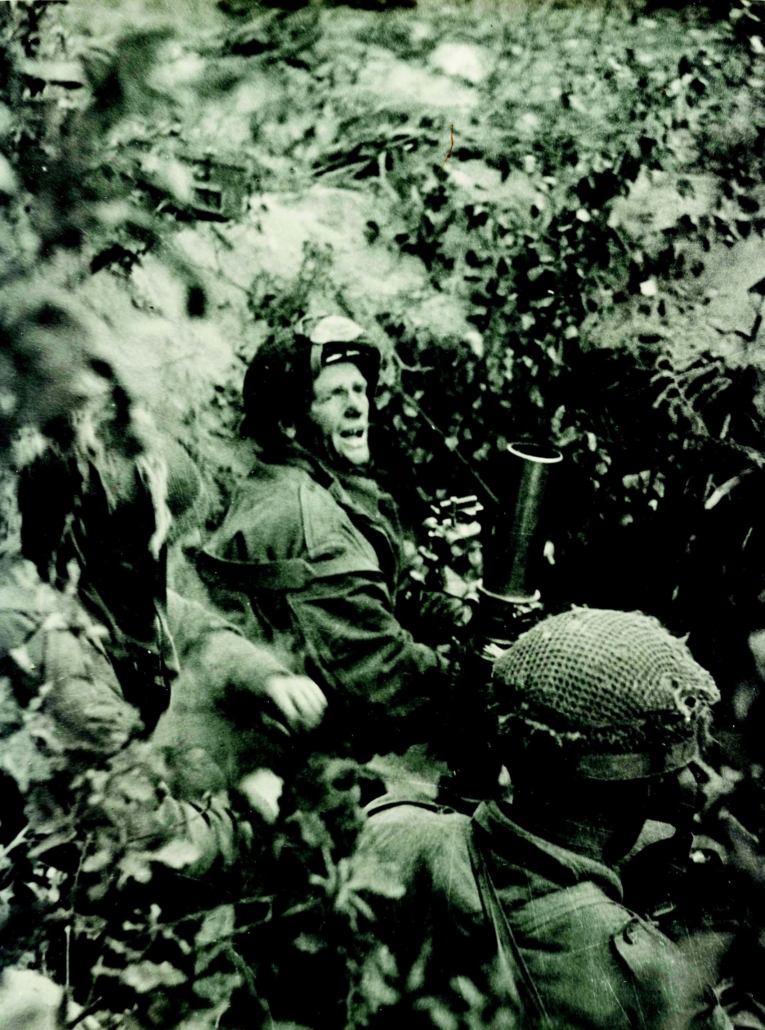
Cover: One of the most ico-nic images from the battle: a 3-inch mortar team from No. 23 Mortar (Handcarts) Platoon, Support Company, 1st Border in their mortar pit on Van Lennepweg in Oosterbeek, 21 September 1944. LTR: Pte Norman Knight, Pte Ron Tierney and Cpl Jim McDowell.
NEWS FROM THE SOCIETY
On the 16th of March we organised our annual general meeting at the Concertzaal in Oosterbeek. These kinds of meetings are predominantly about accounting for the budget for the upcoming year. This general meeting was no exception to this rule.
Briefly stated, and with the bottom line up front, I note that our current financial position is in good shape. The Society counts 644 members at this moment. Nearly all paid their membership contribution. We have noticed that our activities are appreciated and visited by many members. We were able to make most of our activities cost effective. It’s obvious we would like to continue with the activities this way.
Besides the financial paragraph of this meeting we found it necessary to explain the situation concerning our UK members, which numbers have declined dramatically. At this moment just twenty one members remain; most of them are members for life. Producing, translating and distributing three English versions of Airborne Magazine can no longer be sustained and must be directed in a dif-ferent way. After consultation during the general meeting we decided to publish an annual English special of the magazine. We have informed all UK members by a per-sonal mailing, signed by the chairman.
Another initiative that needs some explanation, and which was announced in the chairman’s personal letter, is our intention to explore a closer cooperation with the Arnhem 1944 Fellowship. The Society and the Fellow-ship share a lot of goals and audiences after all. The Fel-lowship counts approximately 600 members, 60% of which live in various places in the world. 40% live in The Netherlands. Two-thirds are a member for life. With a membership contribution of just eleven Euros a year the Fellowship has a smaller budget than the Society. Because of the relatively large amount of UK members the Fel-lowship board consists of UK ánd Dutch members.
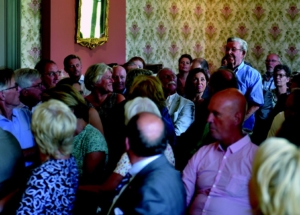
Wim Duyts (foto: Berry de Reus)
On the 31th of May the chairman and secretary of the Society were invited to elaborate on their ideas of this closer cooperation. In our explanation we proposed to invite Fellowship members to participate in the battle-field tours organised by the Society. In addition to this we offered to conduct these tours in English. Secondly, we suggested to exchange each other’s publications. The Fellowship publishes and issues six to seven Newsletters in English by e-mail, where the Society informs its mem-bers by sending them a copy of Airborne Magazine three times a year. We indicated that sending an English ver-sion of Airborne Magazine to the UK members of the Fellowship will result in additional costs. It’s fair to say that the quality of the renewed Airborne Magazine has been widely appreciated by the Dutch members of the Fellowship. At this moment the Fellowship’s reaction to our proposals is still pending. We will keep you posted of course.
Finally it’s worth noting that the Quiet Room in the Airborne Museum was revealed on Sunday the 30th of June. The room was officially opened by the mayor of Ren-kum. The room is a quiet place where visitors can com-memorate the victims of the battle of Arnhem in peace.
In this Quiet Room the awards and medals of veterans and civilians are presented. The opening event turned out to be a milestone for Wim Duyts in his long career in which he held a variety of positions in the board of the Airborne Museum. The awards and medals now present in the Quiet Room were personally handed over to him by foreign and Dutch heirs. It was a debt of honour for Wim Duyts to give these awards a new and striking place in the Museum; the promise that these medals will be presented in an appropriate way has been perpetuated this way. The construction of the Quiet Room has been facilitated through a crowd funding initiative; by donat-ing a substantial amount of money the Society supported this initiative to a significant extent. – Otto van Wiggen, chairman, Society Friends of the Airborne Museum
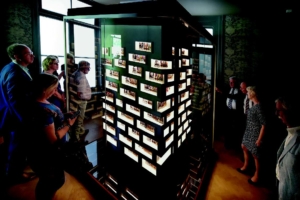
Medals in the Quiet Room (photos: Berry de Reus)
BITS AND PIECES – MAJOR JOHN WADDY’S UNIFORM
The uniform shows various signs of damage, repaired by Waddy with bits and pieces from other uniforms. The parachute wing has a provisional black background, typ-ical of Airborne units formed and trained in India, such as the 156th Parachute Battalion. In the 1990s, Waddy donated his uniform, his name tag from the POW camp and a few other items to the Airborne Museum.
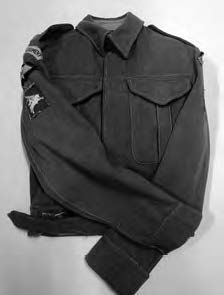
Battle dress of Major John Waddy, comman-der of B Company, 156th Parachute Battalion, The Parachute Regiment (photo: Wybo Boersma).
Major Waddy landed on Ginkelse Heide on September 18 1944 (drop zone Y). 156th battalion was the first unit to leave in the direc-tion of Arnhem. It was on its way around 17:00hrs and went along the Utre-cht-Ede railway line. The next day Waddy’s compa-ny was instructed to push through the positions of A Company to take the higher ground east of Dreijenseweg in Ooster-beek. Waddy got seriously injured while leading his men. A Rhodesian soldier managed to take him to company headquarters. At the regimental aid post, the doctors gave him lit-tle chance of surviving his injuries. Waddy was brought to hotel De Taf-elberg in Oosterbeek, which at the time served as a main dressing station.
Doctor Guy Rigby oper-ated on the billiard table.
Waddy then was taken to a nearby house, where he was wounded for the second time. In his left foot, face and shoulder this time. After the battle, Waddy ended up in a hospital in Apeldoorn, where he stayed for six weeks.
He spent the rest of the war in the POW camp Stalag VII-A near Moosberg, Germany.
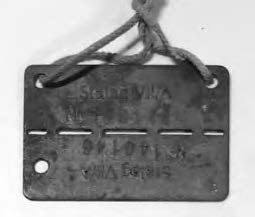
Waddy’s Prisoner of war identification tag (photo: Wybo Boersma).
After the war, John Waddy led various battlefield tours in Oosterbeek. He was also a military adviser for the film A bridge too far. In 1999 his book A tour of the Arnhem Battlefields was published, which is still a must read for those interested in the battle of Arnhem. In 2008 Waddy gave a battlefield tour for the Society of Friends of the Airborne Museum.
– Wybo Boersma
INTERVIEW THE VETERANS ARE THE REAL VIPS
ROGER BEETS’S CHOICES
Roger Beets (1952) is the chairman of the Airborne Commemoration Foundation, the coor-dinating organization behind the commemorations of the Battle of Arnhem in the munic-ipalities of Arnhem, Renkum, Overbetuwe and Ede. With his work for the foundation and for the Airborne March for over 25 years, he has since become a household name in the region. Is the 75th commemoration the big bang before the lights go out? “What they can do in Ypres, we can do too”.
COMMEMORATE OR EXPERIENCE?
“Both. To the words of the Airborne Region [the joint venture of municipalities that wants to make the story of the Battle of Arnhem better known at home and abroad, AH], commemorate and experience, I would also like to add ‘realize!’. The commemorations will continue to exist in their current form, for the time being and you shouldn’t just write that off, especially in this region, where the relationship with the British is deeply rooted.
Take the Sunday morning at the Airborne cemetery: that is the purest form of commemorating. The nature of that commemoration has not changed substantially over the last 26 years, since our foundation runs it. Not even from 1945 onward. That is how it should be. Ede keeps up with the times. And an event like Bridge to Liberation is a different event altogether. With that I mean: one thing does not have to stand in the way of the other.
In other regions of the Market Garden theatre op opera-tion it may have become, in my opinion, a bit too much of operations. But that too can be explained: liberation is celebrated there. Liberation day is not celebrated in Arn-hem. Simply because there was nothing to liberate. The city was empty. In the province of Brabant the situation was a bit different in the September days of 1944: people were actually liberated around that time. It is therefore not surprising that, for example, the gymnastics associ-ations and the local harmonies also walk through Eind-hoven in a parade.
Sometimes you may also see here, in Arnhem and the surrounding area, that some initiatives are not completely in line with the rest of the program. Our foundation tries to see to that. But even then… While you think you have made good agreements in a meeting, ‘no, we only hang one flag’, the moment you walk out things might have changed and people will do what they think best. You have that in a small area with many opposing interests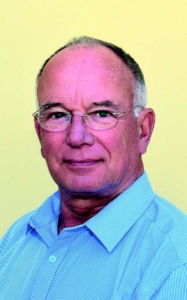
and clubs that are connected to a monument, museum or foundation: the police versus the Defense Ministry, the small businesses, those who don’t want to cooperate with others, VIPs who want to be at the front … All for person-al gains, or so it seems. For me there is only one party that comes first: the veterans with their families. The veterans are the real VIPs. “
MARKET GARDEN OR AIRBORNE?
That is a difficult one. Airborne is part of Market Gar-den. The Market part or the operation took place north of the river. Whether we will ever commemorate Mar-ket Garden together? Do you see Vitesse and NEC [the professional football clubs from Arnhem and Nijmegen, AH] merging? No, the interests are far too different for that. Also because of the commemoration here and the liberation there. The museum in Groesbeek pays a lot of attention to the German story, and also serves a large German public.
The German ambassador has been present at the com-memorations in Arnhem for years. That is not going to happen at the cemetery in Oosterbeek either. The key question that comes back with every fifth anniversary is: what will we do next? Do we have to do something else? “
VETERANS OR YOUTH?
”Gaining and keeping knowledge, that’s what it’s all about. That’s really something of our time: involving the youth, and showing them the importance of history. As a teenager you may be happy sitting by the swimming pool
with your mobile phone, but do realize that someone else went under and never resurfaced in a much larger swim-ming pool. That realization is sometimes hard to find.
Not so long ago research, I believe at the Hogeschool van Arnhem and Nijmegen [university of applied sciences, AH], showed that students are quite interested in his-tory, but that they want to be able to determine what information is good for them. “Don’t bother me with information I don’t need,” was pretty much the opinion, so there is still a lot of ambassadorial work to do for the educational branch of the Airborne community: Primary school groups 7 and 8 are the pupils who are most re-ceptive to the story of the battle, and you don’t have to tell the flower children of Oosterbeek about the history of their village either. That could be very good ambassa-dors. But then schools also need to pay more attention to our regional history. There is so much ignorance, or bet-ter ignorance about the battle of Arnhem. In our school textbooks only three lines are dedicated to the battle of Arnhem, so to speak. Or take the Airborne Museum: they’ll have to be very careful that in a few years’ time they are not left with a beautiful country house in which you will only find one tiny exhibition about the events in 1944. As a museum you obviously have an important role in society.
The men who actually fought here, I mean, the real Arn-hem veterans, that is what it’s all about. That special rela-tionship between Oosterbeek and the veterans, which is not always understood in England, must and will remain.
The village may not have been liberated during the battle, but gratitude for trying is still what defines us.”
ARNHEM OR OOSTERBEEK?
”That is the eternal controversy. I once heard someone from the municipal council say: ‘It is a pity that the bridge is in Arnhem’. Oosterbeek can’t do without Arn-hem, and vice versa. The turning point of the battle was in Arnhem: in the neighbourhood around St. Elisabeth Gasthuis; the events there determined what subsequently happened here in Oosterbeek. “
WALKING OR ORGANIZING?
”Arranging things. I am a real control freak. I am good at getting things done. But I do like walking. As a young-ster I participated twelve times in the Airborne Marches.
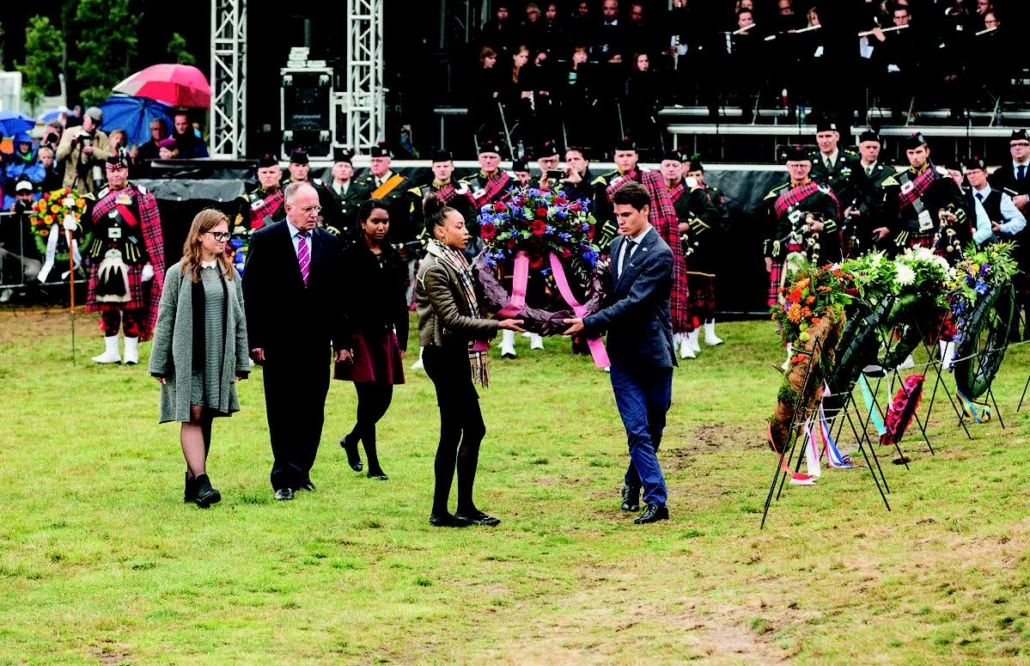
Besides, not many people here realize that the Airborne March is a much larger event than the commemoration in Oosterbeek. That realization had certainly not reached the municipal council before, and still has barely reached a number of businesses in Oosterbeek. Every participant brings along at least one more guest. Do something with the 60,000 (!) people you have in the village, I say. Make sure they’ll come back later.”
BEHIND THE SCENES OR IN THE SPOTLIGHT?
”I usually find it a bit more pleasant behind the scenes. As said: I am an arranger. But I am confident enough to feel at ease if the situation demands it: for example in hosting the parade and in the welcoming of the participants of the Airborne March. Sometimes it is necessary to stand in front of the screen, for example as a master of ceremonies at the Airborne commemoration in Arnhem. Then you also play a part at the front. “
TIE OR POLO SHIRT?
”I chose a polo shirt today, as you can see. I was raised a bit old-fashioned: on official occasions a suit can’t go without a tie. Certainly in England people assume that you dress correctly at commemorations. In The Nether-lands people sometimes tend to attend a funeral in their casual wear, so to speak. That testifies to very little respect or sense of decorum, I think. However, that does not alter the fact that there are occasions when a suit without a tie is appropriate. That is also a sign of the times.”
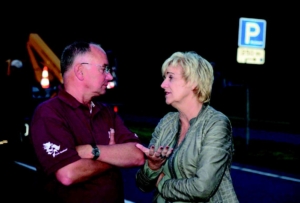
THE 50TH OR 75TH …?
”I was not part of the 50th. The first thing I think about in answering this question is the 60th commemoration.
To be honest: never again! Really. To give some examples: an event was organized in the Vitesse stadium: the vet-erans in their seats, the lights are turned down an then the Dutch 11th Airmobile Brigade comes abseiling from the roof. A mock battle unfolds. Our British guests were shocked. No, that didn’t turn out well.
What I will always remember is the sight of two veterans who were driven over the John Frost bridge to that event in the Vitesse stadium; with tears gushing down their fac-es during the drive. “Why this intense emotion?”, I asked them later. I’ll never forget their answer: ‘We crossed the bridge for the first time.’ Until then it had always been a sort of code of honour never to cross the bridge, and cer-tainly not from north to south. The tacit agreement was that we should not do what wasn’t achieved back then.” – Alexander Heusschen 
SET IN STONE 75 REMARKABLE LOCATIONS FROM OPERATION MARKET GARDEN
Hardly anyone remains who can still share their experiences, but the memories of those days in September of 1944 are never far away. Airborne Magazine collected 75 locations with a story, small or great, taken from obscurity for just a moment. The map on the back cover of the magazine show the rough location by number, or scan the QR code. Using the GPS coordinates on page 35, you can find the exact spot from the comfort of your home (via https://vriendenairbornemuseum.nl/abm15_75digitaleplekken/ of Google Maps) or during your own on-site reconnaissance.
1. Oranjewachtstraat, Arnhem.
Battle damage on the original 1930s stairs (western side of the bridge, bot-tom left standing on the steps)
2. Eusebiusbuitensingel 69, Arnhem. Location of Huis Nijenburgh.
The ample villa of Lady Cornelia, Countess Limburg Stirum, evangelist, benefactor and advocate for Christian education of girls, stood some 100 meter removed from the Westervoort-sedijk crossroads. Lady Cornelia fell victim to the battle.
3. Eusebiusbuitensingel 9, Arnhem.
Advanced headquarters of SS-Sturm-bannführer Hans-Georg Sonnenstuhl, commander of the eponymous Kampfgruppe in the fight against the British troops at the bridge. From here the German troops arriving from Velp and northern Arnhem were deployed, mostly on the western side of the bridge.
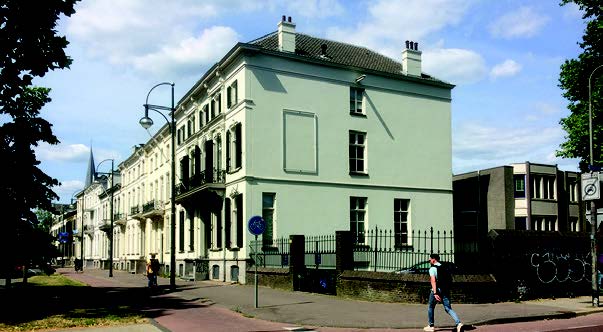
4. Sint Walburgisplein 1, Arnhem.
On september 19th, a low-flying Messerschmitt Bf 109 tried to bomb
the Brits at the bridge. Attempting to avoid British machinegun fire, the aircraft struck the southern tower of Walburgis church. This caused a fire which ended up consuming the entire church. The aircraft crashed into Lau-wersgracht, killing the pilot.
5. Koningstraat 67, Arnhem.
From September 18-22nd, the com-mand post of 1.Kompanie SS-Panzer-grenadier Regiment 21, Frundsberg Division. The battalion had recently been reinforced in Diepenveen.
6. Bakkerstraat 56, Arnhem.
A Schützenpanzerwagen of a battalion of the 1. Pz.Gren.Rgt 21 (see locati-on) had taken position here according to the report of Sturmmann Wilhelm Balbach.
7. Da Costastraat 5, Arnhem.
Paasberg church. Major Tony Hib-bert, commanding the brigade head-quarters of 1st Parachute Brigade, and
members of 2 Para spent the night of 21 to 22 september here as prisoners of war. They were subsequently taken to Villa Bene Sita in Velp (Arnhemse-straatweg 33, Velp).
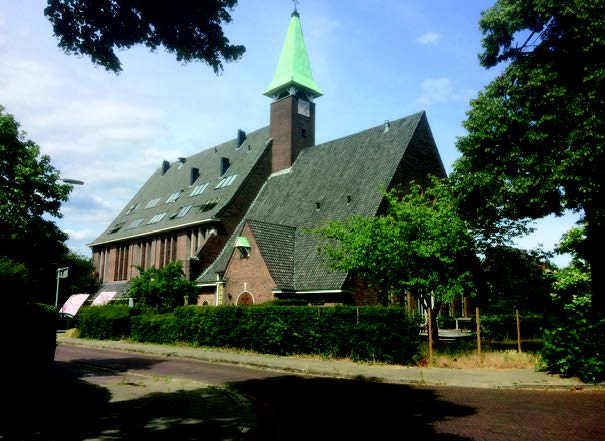
8. Rijksweg-West 65, Arnhem.
Nursing home Oosterveld – Stepping Stones. At the time, Huize Oosterveld of the Onze Lieve Vrouwe (Our Lady) Congregation of Amersfoort. Part of Viktor Gräbner’s column passed the night with their armoured vehicles among the fruit trees in the yard. The occupants refused them entry. Gräb-ner was killed in the morning of Sep-tember 18 1944, when he attacked British positions around the bridge from the South.
9. Hoek Huissensestraat en Orchislaan, Arnhem. At the Corner Huissensestraat and time called Hotel Zuid. Used from September 17 through the 21st as a German emergency hospital. The Dutch GP Johan Drost helped out. The billiard table was used for surgeries

10. Willemsplein 21, Arnhem.
At the time Nieuwe Plein 37-39, Orts-kommandantur from which the Ger-mans oversaw the Arnhem community administration and arranged, for in-stance, the quartering of Wehrmacht troops in the area. The building was a subsidiary target for C Company, 2 Para.
11. Utrechtsestraat 65 , Arnhem.
This house marks the point where the advance of C Com-pany 2 Para was stopped by Ger-man fire on Sunday night. L/Cpl Loney and Pte Shipley died here and were listed as missing for many years. On September 13, 2017 the headstone of as-yet unknown Lance Corporal was replaced. Sin-ce then, plot 20.B.7 has a name: L/ Cpl William Loney. Unfortunately, Pte Shipley’s remains are still missing. [with thanks to M.Anker]
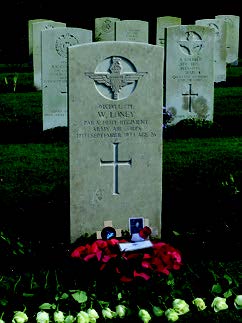
12. Onderlangs 5d, Arnhem. In the
morning of September 19, the men of 1 and 3 Para who had survived the attacks in the direction of the bridge were captured here, some1400 meters from their objective [with thanks to P.Vrolijk]
13. Directly west of Utrechtsestraat
85, Arnhem. The original fence, askew and overgrown, marks the furthest ad-vance of the British attack on Septem-ber 19, 1944.
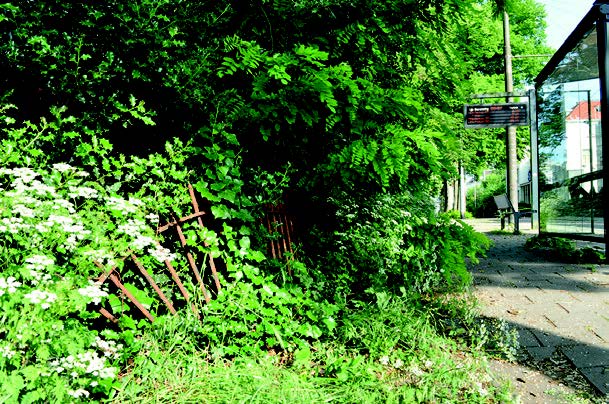
14. Utrechtseweg 87, Arnhem. Next to
the entrance to the garden of Museum Arnhem a discreet transparent tile is em-bedded in the sidewalk. Visible are the contours of a fallen German soldier who, so the story goes, was found there in that position. Others say he fell in Russia.
15. Utrechtseweg 87, Arnhem.
An ornament on a side wall of the municipal museum bears the scars of war. Whether they are a result of the September days or from a later period is (as yet) unknown.
16. Opposite the entrance of Bo-venover, Arnhem. Arnhem remained
in the front lines until April 1945. The Occupiers had ordered the civilian popu-lation to leave the city, now ‘Sperrgebiet’.
In the abandoned city, forced laborers worked on defensive positions. The Koch bunker was built during this period.
17. Braamweg 1, Arnhem.
The imposing Villa Heselbergh had stood along the Apeldoornseweg in Arnhem since 1912. In 1943, it was requisitioned to house the staff of Feldkommandantur (FK) 642 ‘Arn-heim’. The FK had a leading role during the battle. As second in com-mand to the late Generalmajor Kus-sin, Major Schleifenbaum and his staff remained in position during the battle around the bridge. The villa was also taken into use as HQ of the 9.
SS-Panzer-Division ‘Hohenstaufen’.
For ten days, it was visited daily by German commanders such as Walter Model, Wilhelm Bittrich and Walter Harzer. On this location, Germans and Brits negotiated, prisoners of war were interrogated and Dutch civilians were shot by firing squad. As a result of the allied artillery barrage during Operation Anger, the crossing of the Ijssel river and clearance of Arnhem, the villa was destroyed. Currently, the area is being redeveloped. The prepa-tory archaeological examination has brought numerous traces and objects to light related to the war history of this spot.
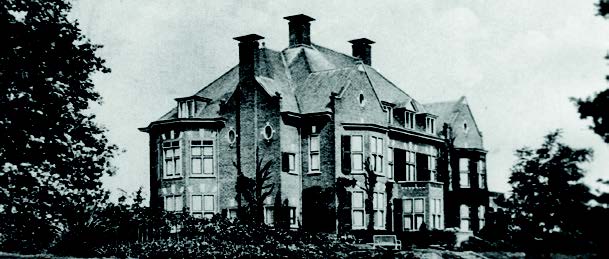
18. Weg achter het Bos, Arnhem.
Temporary German military cemetery on the terrain of the Saksen Weimar Barracks. In the sources, the cemetery is referred to as the ‘Heldenfriedhof SS-Unterführerschule Arnheim’.
19. Wagnerlaan 55, Arnhem.
Municipal hospital / Kriegslazarett.
During the battle, German wounded were treated here. On the western side of the hospital a cemetery was dug for any that died. On the eastern side were several British graves.
20. Noordelijke Parallelweg 55, Arn-
hem. This former church hall was the headquarters of SS-Hauptsturmführer Hans Möller (see location 21). After the war, the building was expanded to the edge of the street. The tip of the church hall is still visible from there.
21. Utrechtseweg 304, Arnhem.
Villa Casa Blanca, the white buil-ding in this yard, was defended by a platoon of T Company 1 Para on September 19 1944. According to well-informed sources, this is also the villa where Hans Möller of SS-Pan-zer-Pionier-Bataillon 9 lost a compa-ny commander on September 17. On that night, Möller withdrew his unit of some sixty men to the area around the Oranjebrug in Arnhem after a fi-refight with A Company 2 Para. This allowed John Frost to pass through via Utrechtseweg and the towpath along the river.
22. Klingelbeekseweg 134, Arnhem.
Modest, small commemorative plaque for the four South Staffords who were captured here by the SS.
23. Directly west of Schelmseweg 67,
Arnhem. Location of Ehrenfriedhof Zijpendaal, the temporary cemete-ry for the German dead, before they were moved to Ysselsteyn (Limburg province).
24. Koningsweg 13, Arnhem.
The Diogenes bunker was the com-mand and control center for the air defense of the Netherlands, part of Bel-gium and the Ruhr area. The Germans attempted the destroy the already dis-mantled Kampfraum, the nerve center (map room) of the complex, when the British landed on September 17.
25. Amsterdamseweg 461, Arnhem.
Location of the Lichtenbeek villa, during the battle headquarters of SS-Hauptsturmführer Klaus von All-wörden, commander of SS-Panzerjäger-Abteilung 9.
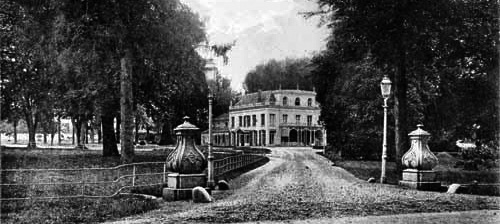
26. Klingelbeekseweg 69, Ooster-
beek. Oosterbeek-Laag train station, the walls on its western side still show battle damage. The station was on the British route into town and lay on the front lines until April 1945
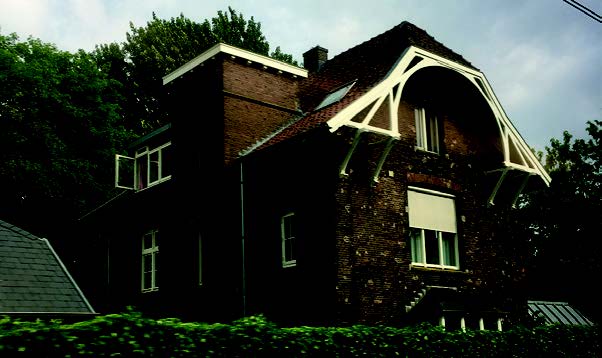
27. Mariëndaal 8, Oosterbeek.
Mariëndaal house. In the night of Sep-tember 17, this was the headquarters of the commander of SS-Panzer-Artil-lerie-Regiment 9, SS-Sturmbannführer Ludwig Spindler.
28. Benededorpsweg / Klingelbeeks-
weg, Oosterbeek. The railway tunnel has also been called the Menin Gate (af-ter the gate in Ypres, Belgium) of the Battle of Arnhem.
Almost all British troops who fought in western Arnhem pas-sed by here. The clearly visible battle damage on the southeastern side was probably caused by German rifle and machinegun fire.

29. Matzer van Blooisplantsoen, Oos-
terbeek. Site of the Van Hofwegen laundry, a strategic location in the eastern part of the Perimeter because
of its solitary, elevated position in rela-tion to the British positions around the church and its field of fire to the east.
Major Robert Cain won his Victoria Cross here. TV presenter Jeremy Clarks-on narrates the story of Cain, his father in law, in ‘The Victoria Cross: for va-lour’, which can be found on Youtube.
30. Benedendorpsweg 141, Ooster-
beek. Clearly visible battle damage on the façade, especially in grazing light.
31. Weverstraat 177, Oosterbeek.
Strike marks from bullets can be seen in the lower section of the wall, at about knee height. The adjoining houses are part of the backdrop to Theirs is the Glo-ry, the British movie about the Battle from 1946.
32. Weverstraat 181, Oosterbeek.
Battle damage tot he garden fence. The spot is easy to miss, if not for the tourist buses that regularly pull over and batt-lefield tourists taking photos, who give the game away
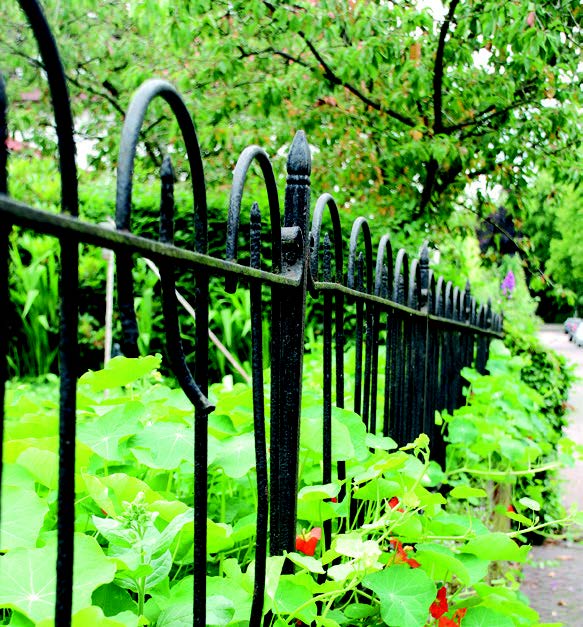
33. Kneppelhoutweg 14-A, Ooster-
beek. Site of the ULO-school, famous for the staged photo of glider pilot Sgts Whawel and Turl (right), looking for snipers according the sources. Turl was killed on September 25th.
34. Kneppelhoutweg 14, Ooster-
beek. Location of ’t Hemeldal boarding house, one of the sites where Polish sol-diers who managed to cross the Rhine (see also 35), were deployed. Now a woodlot.
35. Corner of Benedendorpsweg and
Hemelseberg. Around the Villa Trans-
valia, some of the Poles who crossed the Rhine in the night of 22-23 September took up positions (see also 46). The Vil-la did not survive the war.
36. Behind Benedendorpsweg 194,
Oosterbeek. Foundations of the gas holder: easily recognizable in lower Oosterbeek, the site is often mentio-ned in battle and eyewitness reports.
The gas factory, next to it, is now an architects’ office. Battle damage is visi-ble from the path along the floodplain.
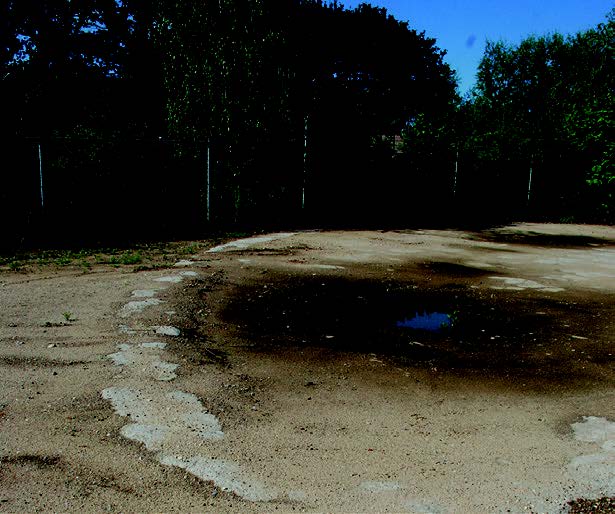
37. Benedendorpsweg 210, Oos-
terbeek. Schoon-Zicht house, the Arnhem and Oosterbeek resistance groups met here under Antoon van Daalen, used by 1st Border during the battle.
38. Path along Benedendorpsweg
168, Oosterbeek. One of two routes into the floodplain during Operation Berlin, the retreat of 1st Airborne Di-vision from the perimeter.
39. Nederrijnoever, Oosterbeek – directly south of the Old Church.
In 2003 Sergeant M.J.Potter unveiled this robust monument, which is hard to reach due to its location. It is set at one of the two crossing sites (see also 38).
40. Van Borsselenweg 37, Ooster-
beek. Headquarters and first aid-po-sition of 1st Battalion, The Border Regiment. At what is now a bicycle path, next to the entrance gate to the Glock estate, the British disabled an enemy Char B1 tank.
41. Utrechtseweg 232, Oosterbeek.
The Hartenstein Hotel housed the operational staff of the Heeresgrup-pe B headquarters, commanded by Generalfeldmarschall Walter Mo-del. The quartermaster department was garrisoned in Wisch Castle in Terborg. Hartenstein was evacuated around 1.30PM on September 17.
When the “Fallschirmjäger in der nähe” (paratroopers nearby) report came in, Model and General der Infanterie Hans Krebs immediately left for Doetinchem, via the Arnhem Ortskommandantur (see 10) and Feldkommandantur 642 (see 17), where SS-Obergruppenführer Bit-trich, CO of II.SS Panzerkorps, was based at Slangenburg Castle. Having arrived at Castle Wisch in Terborg, the headquarters of Heeresgruppe B was operational again around 5PM.
From the late afternoon of Septem-ber 18 until the retreat in the night of 25-26 September, Hotel Hartenstein served as headquarters of 1st Airbor-ne Division.
42. Hoofdlaan 1, Oosterbeek.
Regimental Aid Post of 1st Border.
The adjoining house on Van Len-nepweg housed the Battalion’s head-quarters. In the park across from the headquarters, Support Company provided fire support for the Border compagnies deployed on the western perimeter between Utrechtseweg and the Rhine river.
43. Utrechtseweg 269, Oosterbeek.
In this house Major General Roy Ur-quhart, CO 1st Airborne Division, and Brigadier Lathbury, comman-ding 1st Parachute Brigade, spent the night from 17 to 18 September.
44.Utrechtseweg-Wolfhezerweg junction, Oosterbeek.
The famous crossroads whe-re Kussin (see 17) drove to his death has been changed, moving the co-lumns marking Hoog Oor-sprong estate.
The colums still bear battle damage.
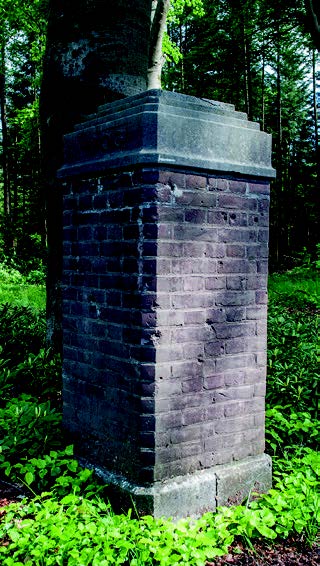
45. Pietersbergseweg 34, Oosterbeek. The two attic windows under the eaves were used by the snipers Sgt.Tony Crane and his comrade.
Their score, “killed or wounded” was kept on the wallpaper now exhibited in the Airborne Museum.
46. Paul Krugerstraat 21. The unof-
ficial plaque on the former bakery re-cognizes the fight of A and D Troop of the Reconnaissance Squadron in this area of the Perimeter. The REC-CE Squadron is well represented among the many monuments on the past battlefield.
47. Steijnweg 40, Oosterbeek.
Secondary position of the anti-tank gun of Sgt.George Barton of the King’s Own Scottish Borderers.
It first fought at the White House (Hotel Dreyeroord). John Crosson, recently active in the fight to preser-ve the hotel, was active in the area as sniper.
48. Johannahoeve 4, Oosterbeek.
Vrijland Mission House, at this site stood Waldfriede house, which was destroyed in 1944. It served as head-quarters for SS-Sturmbannführer Sepp Krafft, commander of the SS-Panzergrenadier Ausbildungs-und Ersatz-Bataillon 16 when the British began to land.
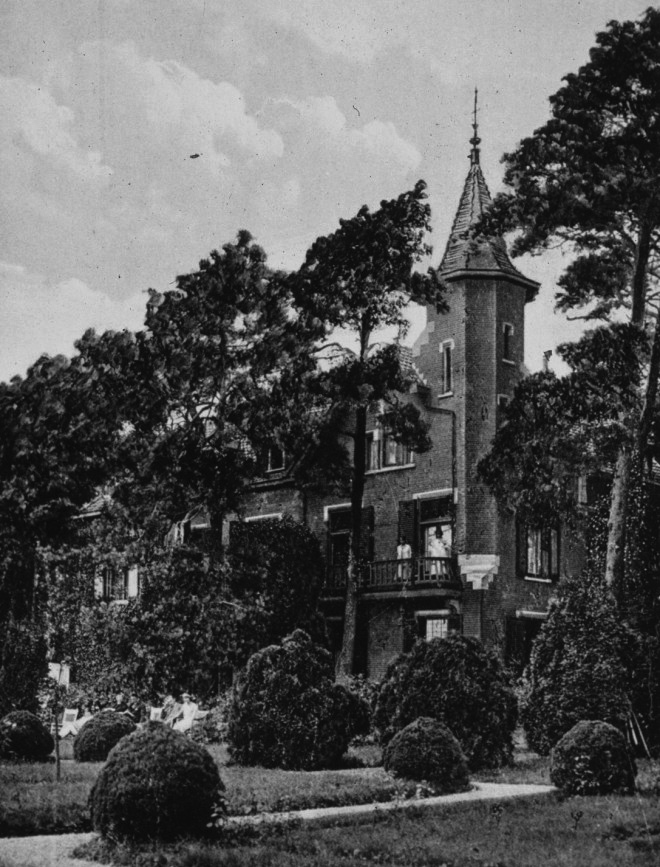
49. Close to Zonneheuvelweg 18,
Oosterbeek. The only remaining water tower of Oosterbeek, built in 1938. It was used by the 2. Kompa-
nie van SS-Panzergrenadier-Ausbil-dungs- und Ersatz-Bataillon 16 as an observation post during its fight with 3Para. During this engagement, Ur-quhart’s jeep was disabled.
50. Wolfhezerweg 17, Wolfheze.
Hotel-Restaurant Wolfheze.
Hotel-Restaurant Wolfheze, headquar-ters of Sepp Krafft (see 48) after the British landings until about 9PM on September 17 1944.
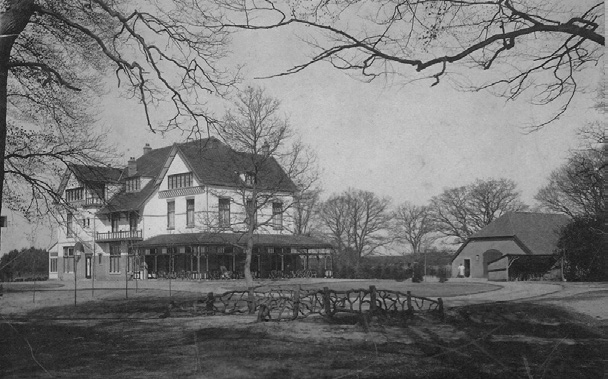
51. Doorwerthse Hoek 1, Driel.
Ruines of the brick factory Korevaar.
The remnants of the chimney bear witness to the vicious fight for this German bridgehead. Traces are even visible from the dyke at Driel. On October 1st, German troops crossed the river and held the Terwindt and Korevaar brick factories until Oc-tober 11th. SS-The command post of Obersturmbannführer Heinrich Oelkers, commander of the German troops, was at the site of the destro-yed chimney.
52. Veerweg, Renkum. Battle damage
on the western wall of one of the ovens of the brick factory, silent witness of the morning of September 18, 1944
when the 4. Kompa-nie of the 10. Schiffs-stammab-teilung dro-ve the men of B Com-pany of the Border Regiment from the brickworks.
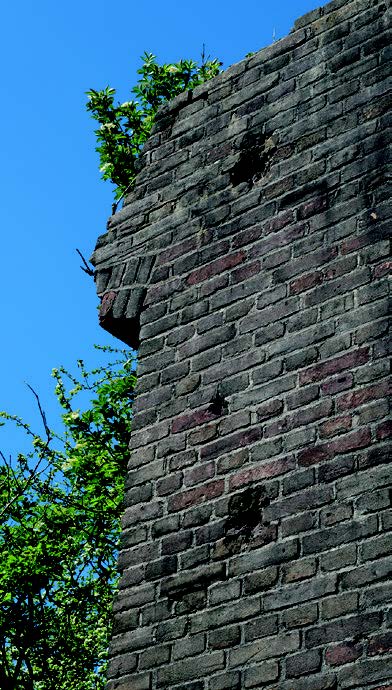
53. Corner of Eikenlaan and Klin-kenbergerweg, Ede. Modest com-
memorative site (bench) for two ladies from Ede who while taking cover behind a bush at the corner of Artillerielaan, were fired at by a Ger-man patrol on September 18, 1944.
They and their families lived in the house behind the bench. The patrol was sent out in retaliation of the theft of a German rifle, elsewhere in Ede.
54. Oude Lunterseweg 28, Ede.
Meeting site for the Binnenland-se Strijdkrachten (resistance forces) and hiding place of Tony Hibbert (in the cupboard under the attic stairs).
Much of Operation Pegasus I, the plan to bring British soldiers left north of the Rhine back to Allied li-nes, was prepared here.
55. Southeast corner of Hunnerpark,
Nijmegen. A steel time capsule contai-ning documents and items from Opera-tion Market Garden was buried below the inscribed covering stone in 1974. It will be opened on the occasion of the centennial of the Battle, in 2044. Some patience still required.
56. Valkhof, Nijmegen. The Valkhof
Bunker from 1943 was hidden for nearly 70 years beneath the Valkhof.
This and the other bunkers, reinfor-ced houses, trenches, tank ditches and barbed wire proved very useful to SS-Hauptsturmführer Karl-Heinz Euling and his defenders of the Waal bridge. The bunker can regularly be visited.
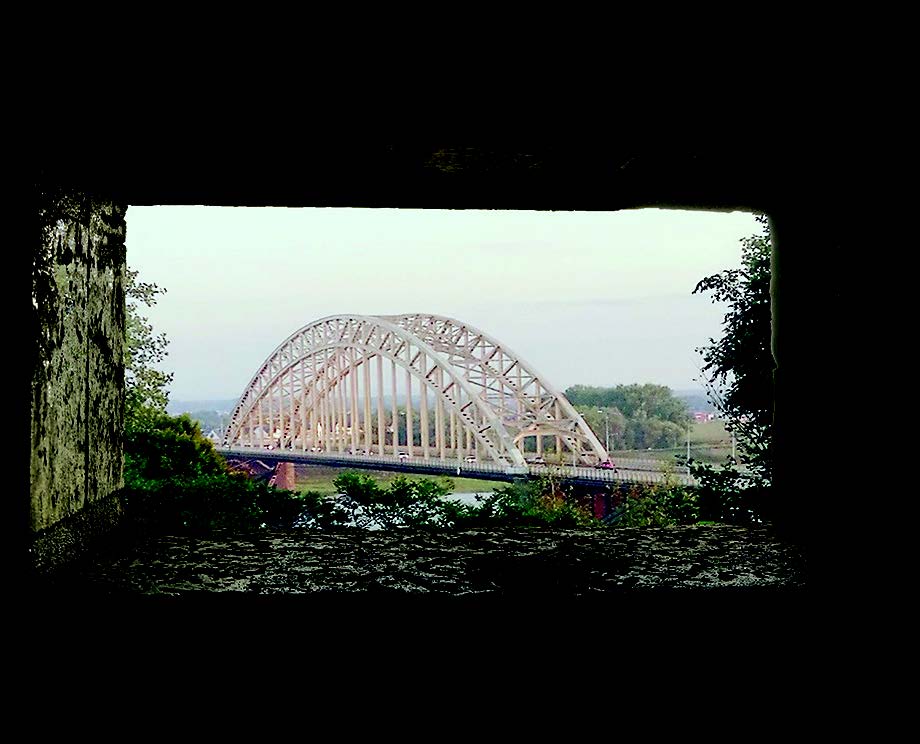
57. Prins Hendrikstraat 6, Nijmegen.
The large repaired shell hole can clearly be seen at the top of the side wall, re-cognizable by its splash pattern. The da-
mage was probably caused by German shelling from the Betuwe (the Island) area on September 20 or 22nd 1944.
On November 10th, this area of Nijme-gen was shelled again.
58. Lentse Warande, Lent. Large
concrete blocks were excavated from the Waal dyke embankment during public works in 2013. They appea-red to be the German barriers built in 1943 which forced the Shermans of Robinson’s Troop to maneuver around them when they charged across the Waal bridge in the evening of September 20, 1944.
59. Oosterhoutsedijk, Lent. A new
bridge across the Waal river was ope-ned in 2013. It was named ‘De Over-steek’ (‘The Crossing’). Two veterans were present at the opening, together with relatives and descendants of the 48 Amerians killed during the cros-sing. In honour of these men, the bridge is equipped with 48 pairs of light poles, which turn on in succes-sion from south (Nijmegen) to north (Lent) at the speed of a slow march.
The original monument was moved next to the bridge.
60. Waaldijk, just west of Dorpstraat,
Oosterhout. Pvt. John Towle (19) of the 82nd Airborne Division sin-gle-handedly engaged two Panzer IV tanks and a halftrack here on Sep-tember 21 1944. Using a bazooka, he forced the vehicles to retreat into Pe-perstraat, at the cost of his own life.
He was one of three men of the 82nd Airborne Divison to be awarded the Congressional Medal of Honor du-ring World War 2.
61. Directly north of Valburg-sestraat 7, Slijk-Ewijk. Definitely
within Slijk-Ewijk instead of Val-burg, yet the site of the ‘Valburg Conference’ during which the Polish Maj-Gen Sosabowski was told off by the commanders of 43rd (Wessex) Infantry Division and XXX Corps. In ignoring Sosabowski’s military analy-sis of the severe situation in Ooster-beek and providing him with the or-ders that they did, they sounded the death knell of Market Garden. The conference planted the seed for the
decades-long British accusation that the Polish brigade caused the opera-tion to fail.
62. Groesbeekseweg 152, Nijmegen.
After the battle, evacuated British soldiers were housed in the Bisschop Hamerhuis (‘the Pagoda’), in 1944 a Mission house and seminary. This is one of two other large locations: schools of the order of the Filles de la Sagesse.
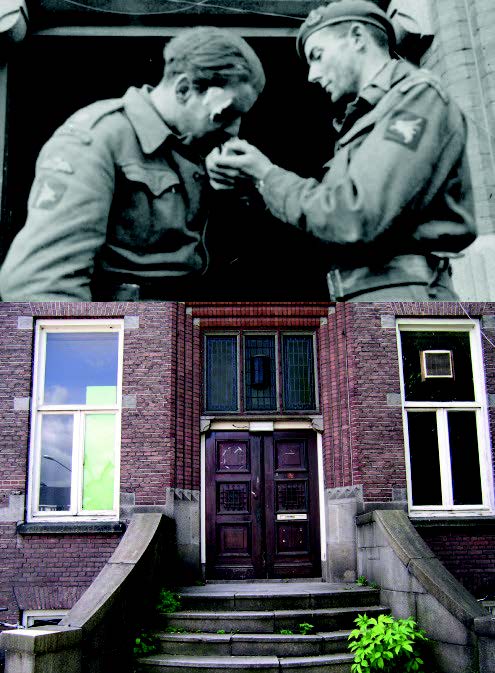
63. Meijhorst 6010 and Lankforst
5101, Nijmegen. After several days of trying, Sgt.Norman Patten of No.1 Forward Observation Unit of the Royal Artillery managed to es-tablish contact with 64th Medium Regiment, which had taken positi-ons around here in Nijmegen. On September 21, Patten came on the net identifying himself as represen-ting “People you are trying to meet”.
Having elaborately established his credentials, the first shells were fi-red at German troops concentrations around Heveadorp and Westerbou-wing from the Nijmegen Ducken-burg/Hatertsche Broek area around 11.30AM. As the range of the guns was limited to the area south of Utrechtseweg, they were redeployed to the southern side of the Waal river, about where the new bridge (see 59) now lays. From here, all threatened positions of the surrounded Division could be supported 64. Directly north of the bend in Panovenlaan, Nijmegen.
Temporary airfield for the Piper Grasshopper reconnaissance aircraft of 456 Para Field Artillery Battalion, 82nd Airborne Division. It was taken into service on September 26, 1944.
Still visible on the southern side of the one-time airstrip is the area whe-re several trees were removed to make space. The line of newly-planted trees shifts in relaton to the old growth.
65. Between Vosseneindseweg 11a
and 11b, Heumen. Air strip of XXX Corps, probably used from Septem-ber 19, 1944.
66. Hoogenhofseweg, Molenhoek.
A temporary cemetery for the 836 dead of the 82nd Airborne Division was dug in the garden of the Berg-zicht estate, between the buildings and Hoogenhofseweg, in use from September 20 1944.The monument on the corner of this road and Mo-lenstraat is sited erroneously.
67. Blocking line at railway cros-sing Biesseltsebaan Groesbeek/
Malden. The first German evacuati-on train was able to escape on Sep-tember 17. After that, the troopers of the 82nd Airborne Division deployed in the woods at Groesbeek were more alert. They blocked the railway. The second German train collided with it and rolled all the way back to Panovenlaan in Nijmegen.
68. Forest track, Groesbeek. Arie
Bestebreurtje’s first Jedburgh action took place near here on September 17, 1944. Bestebreurtje led the Jed-burgh team code-named Clarence, that was to act as the liaison for the 82nd Airborne Division. Bestebreur-tje was in the same aircraft (the first) as divisional commander Brigadier General James Gavin and his Divi-sion HQ Group. The pair landed around 1.15 PM on dropzone ‘N’.
Soon after the drop, he and Gavin got involved in a firefight during which Bestebreurtje shot a German machinegunner through the head, re-scuing Gavin’s life. Later that week, Bestebreurtje recruited the 22-year old resistance fighter Jan van Hoof.
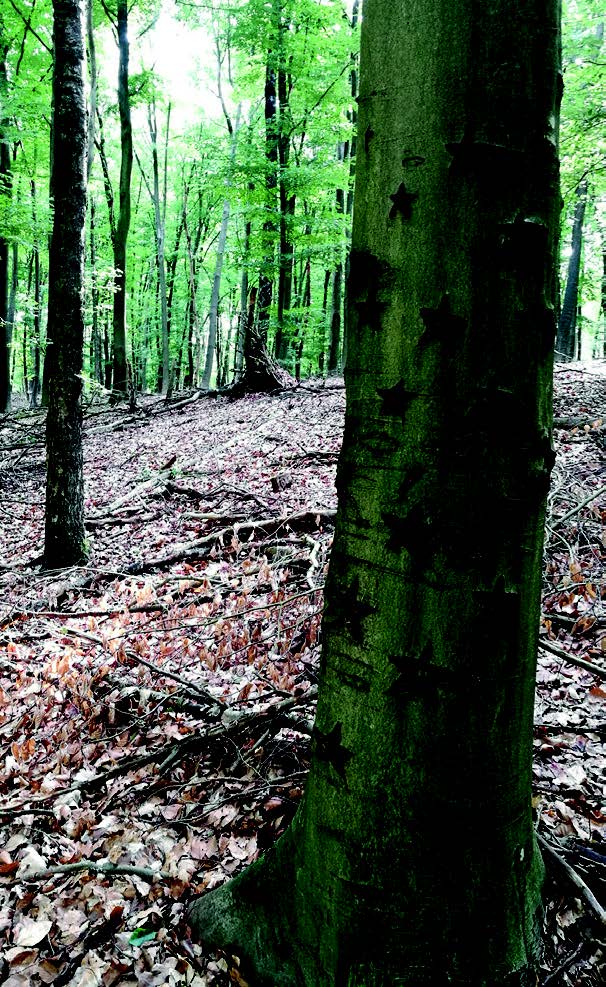
69. Mooksebaan 10, Groesbeek.
Clearly visible battle damage on the left-hand side of the façade.
70. Molenbosweg 17, Berg en Dal.
Hotel Erica, headquarters of the Se-aborne Echelon of 1st Airborne Di-vision. The basements of this hotel sheltered inhabitants of Nijmegen during the heavy fighting for Nij-megen, the landing zones to the sou-theast of town and the woods around the hotel.
71. Thornsestraat 20, Persingen.
A hamlet with a mill stood around here from the 15th century until 1944. During operation Market Gar-den, Fallschirmjäger fought around here with G Company, 508th PIR, 82nd Airborne Divison, who had the community as its objective. Fire-bombs destroyed it entirely on Sep-tember 25th, though the mill was rebuilt in 2015-2016.
72. Heuvelsestraat 5, Bemmel. On
a small raise in the flat Betuwe lands-cape lies Den Heuvel (“The Hill”).
On and around this site German and British infantry and tank units fough viciouslyt in September and October.
To commemorate the fallen, a small chapel was built in 1944. It is perhaps the only monument in the larger area
to memorialize soldiers of II. SS Panzer Korps as well by way of a list of names.
73. Boveneindsestraat 20, Kesteren.
The local resistance brought a number of soldiers of 10 Para who had jumped early on their way to Ginkel Heath, to this farm. The Dakota they were in crashed past Dodewaard. The paratroo-pers were eventually able to escape to Allied territory.
74. Slope behind Waalstraat 2, Tiel.
A stone tile commemorates the four-teen civilians from Wamel who were executed here on September 1944 by the “Unreasonably insane German”.
The execution was in retaliation for shots fired at the ferry in the euphoric atmosphere due to the “coming Libera-tion” that Market Garden was to bring.
75. De Montignylaan 18, Willige
Langerak. Grave of Pte Clarence Ash, the westernmost grave in the Nether-lands for the Battle of Arnhem, 80 kilometers downstream from Oos-terbeek. Pte.Clarence Ash of the 2nd Battalion The South Staffordshire Re-giment drowned in the night of 25-26 September 1944 during Operation Berlin. His body wasn’t found until November 18, 1944.
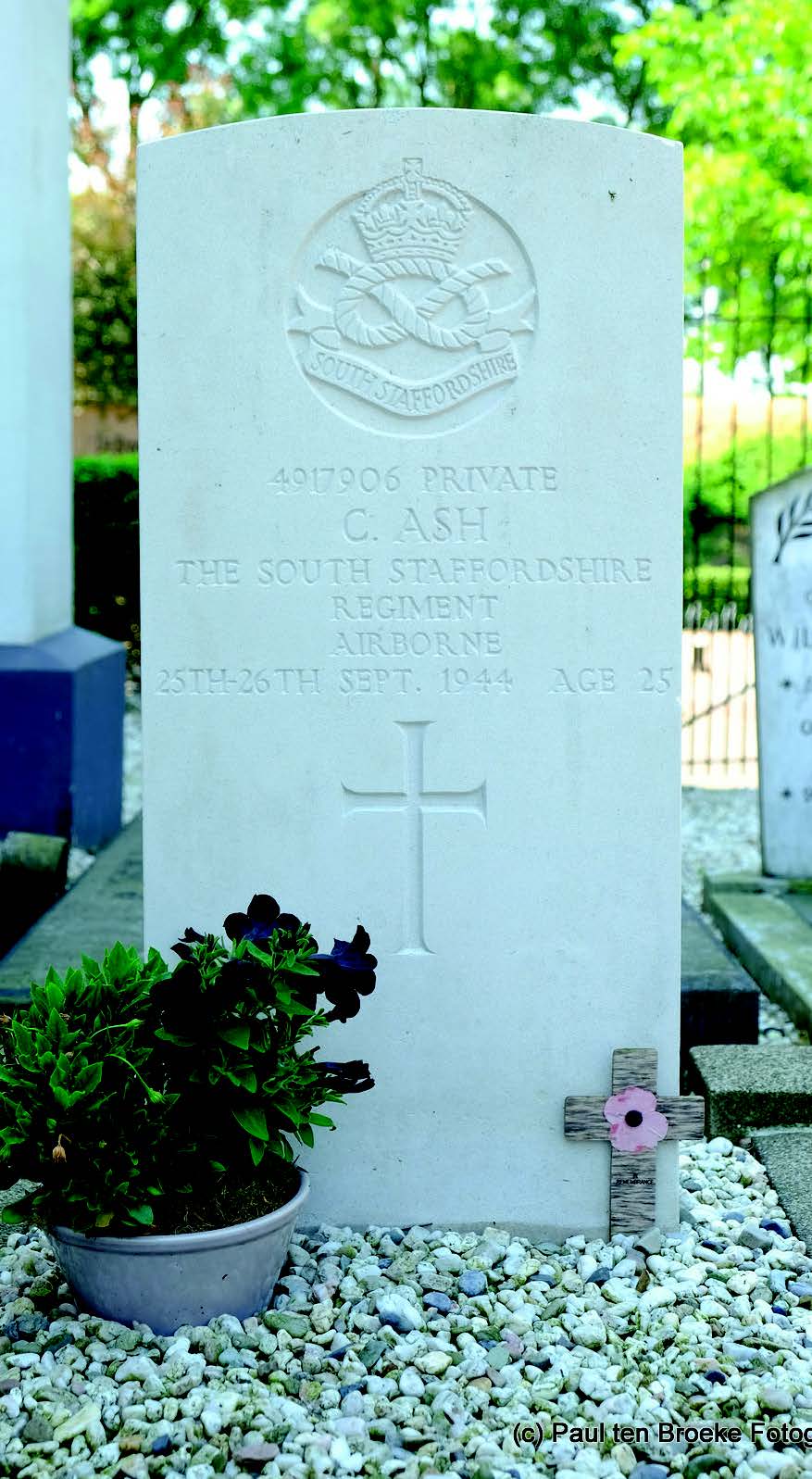
FOLDED-BACK PAST
THE POSSIBLE SALVAGE OF THE TYPHOON WITH FLIGHT SERGEANT HURRELL
The Dutch Minister of the Interior and Kingdom Relations, Kajsa Ollongren, decided last autumn to make work of salvaging dozens of aircraft wrecks from the Second World War.
With the approval of almost the entire House of Representatives, with the exception of the DENK party, the way has been cleared for searching around 30 to 50 missing pilots on Dutch soil. One of them is William Hurrell. He crashed on the 26th of September 1944 with his Hawker Typhoon at Eefde (Gelderland). His remains must still be in the machine.
During my work for Kadaster (the Dutch Land Regis-try Office) I accidently came across a monument near Eefde a while ago, with a name on it that I could relate to Market Garden. The archaeological association De Elf Marken, who had the monument erected twenty years ago, appeared to have made various attempts to find out more about Flight Sergeant William Hurrell, fighter pi-lot in No. 175 Squadron, the Royal Air Force Volunteer
Reserve. Hurrell’s data are included in the SFAM Roll of Honour of casualties during the Battle of Arnhem, which can be consulted at www.marketgarden.com.
On Tuesday afternoon the 26th of September 1944, at 12:35 pm, six Typhoons took off from the Deurne air-field in Belgium for an armed reconnaissance flight over The Netherlands. The aircraft were part of the 175th squadron of the Royal Air Force. It was Hurell’s third operational flight.
The six reached Apeldoorn around 13:00hr when they were suddenly surprised by more than 50 Messerschmit-ts Bf 109 who were active there because of the Battle of Arnhem. Flying Officer Clarke and Flight Sergeant Hur-rell were attacked before they could spread. Clarke’s air-craft was hit several times, but was still able to reach the base in Deurne. The other aircraft also managed to find a safe way out. Nothing was heard from Hurrell anymo-re. Subsequent investigations by the Ministry of Defence Air Historical Branch 5 (RAF) revealed that his plane was shot down by Leutnant Klaffenbach (or Klassenbach) of 111 / JG4 and probably fell from a great height. It ended up in a piece of land on Lindeboomweg in Eefde, where it penetrated so deep into the ground that salvaging the machine proved impossible.
SIGNET RING
Shortly after the war attempts were made to find out the identity of the crew, which is evident from a reaction of the mayor of Gorssel to a memorandum from the Minis-try of War (8 April 1948) informing about the remains of ‘one or more pilots’: “Following the aforementioned letter, I inform you that on 26 September 1944 near Eefde an allied aircraft, with its missiles on board, crashed in this municipality after an air battle. In September 1945 I commissioned a further investi-gation into the identification of the aircraft and any crew.… There were also some human remains present: bones (no teeth or molars) and part of a hand. A signet ring with a mono-gram, HW or WH, was found. Nothing else was found from which the identity of the crew could be established.
On June 23 1946 I received a visit from Capt. I. Ness of the Royal Air Force investigation service […] who took the identification tags and signet ring. […] The site where the aricraft has penetrated the ground is not marked by a burial sign and the site of the disaster is not considered a grave. The land is used as arable land. The place can be indicated with certainty. (source: W. van de Kamp, Ons Markenboek, vol. 13 no. 2 and vol. 17 no. 2).
MEANINGFUL
In 1994, Hurrell’s name came to light in a new investiga-tion. Where it was initially thought that the aircraft was flown by a Belgian pilot, it could now be established for
the first time that it was a pilot with a British identity: that of the missing Flight Sergeant. Attempts to have his field grave registered as a war grave with the Common-wealth War Graves Commission in Ypres proved to be less successful. And so it is thought that Hurrell still rests in the machine in which he disappeared into the ground in 1944. A while ago the Dutch Air War Study Group nominated the location of the Typhoon for future sal-vaging. The army subsequently carried out a deep scan with a ground radar at the crash location in September 2018. With Ollongren’s “meaningful and fitting gestu-re that should do justice to the wishes of the relatives of killed crew members”, Hurrell’s MIA status could soon come to an end. The money is available and the locations with the remains have been given priority on the list of ‘promising salvages’ that the Salvage Service of the Royal Netherlands Army has created. It would be fitting if this ultimate attempt would lead to a funeral with military honour from this 21-year-old RAF pilot.
One wish of Hurrell’s recently traced second cousin, Bry-die Hurrell from Australia, has already been met: after 75 years the family finally knows where William most probably is.
– Frans Ammerlaan
THE BATTALION THAT DISAPPEARED INTO THE WOODS
156TH BATTALION THE PARACHUTE REGIMENT IN THE BATTLE OF ARNHEM
On Sunday the 28th of April 2019 the Society of Friends of the Airborne Museum organ-ised a battlefield tour 156th Battalion in the battle of Arnhem. Our guide was Nick Kelso, a Briton living in The Netherlands and an acquaintance of John O’Reilly, author of two excellent books on this battalion.
In 2009 John O’Reilly, son of a 156th veteran, pub-lished From Delhi to Arnhem. In 2017 this was fol-lowed by a supplement Walking in Their Footsteps.
Both books are enormously detailed and contain wonderful maps. Both books are used to publish this article. Also consulted is at Arnhem (1976) by Tom Angus, a pseudonym for Geoffrey Powell. This for-mer company commander takes you by the hand and guides you through the woods. Brigadier Hackett’s I was a stranger starts telling the story after his 4th Par-achute Brigade was destroyed in the killing woods.
Losing his brigade was probably a too traumatic issue to write about. A pity because we would like to have an idea why certain decisions were taken that led to that catastrophe.
FORMING THE BATTALION
The formation of 156 Parachute Battalion starts with a directive of Winston Churchill from May 1940 following the German parachute operations in Den-mark, Norway, The Netherlands and Belgium (Eben Emael fortress).
In India the 50th Parachute Brigade was formed. This brigade consisted of the British 151st, raised on the 15th of October 1941, the Indian 152nd and the 153rd Gurkha Parachute Battalions. The 151st Bat-talion left for the Middle East. There its name was changed into 156th Battalion in order to mislead the enemy. In 1943 Lieutenant Colonel Des Voeux took command. On arrival in Kabrit (Egypt) the para-chutes brought from India turned out to be rotten; new ones had to be ordered. David Sterling’s Special Air Service intercepted the new parachutes for his ac-tions behind enemy lines, and most parachutes were lost again. In Egypt the 4th Parachute Brigade was formed. This led to personnel changes. Many of the original 156th Bn. found new posts in the 6th Air-borne Division and other battalions. Captain Lons-dale for example became second in command of the 11th Parachute Battalion in Palestine. The battalion wore Indian bush hats. The divisional commander had to issue an order for wearing the red beret.
OPERATIONS
The battalion had no role in the Sicily invasion in July 1943. It wasn’t until September before the battalion saw action in southern Italy as part of the 4th Par-achute Brigade of the 1st Airborne Division. After this experience the battalion moved to England in November 1943. It arrived in Liverpool on the 10th of December. Green fields and British beer made an everlasting impression. The battalion was initial-ly stationed in Rutland, but Des Voeux centred his units around Melton Mowbray. At Ringway, what later became Manchester Airport, refresher parachute training was organised. Training during the day was followed by social events in the evening. Some mem-bers of the battalion found their (future) wives dur-ing those events. Sergeant Humphreys met a certain Margaret Roberts. Years later, in 1979 she entered the world stage as Margaret Thatcher.
The battalion was disappointed not to have been part of D-Day. 4th Parachute Brigade was standing-by. Be-
fore Market Garden fifteen operations were planned and cancelled. During Operation Comet, initially named Operation Fifteen, B Company of the 156th, led by Major John Waddy, as coup de main -was to drop north of the Grave bridge. During the briefing Major Geoffrey Powell of C Company whispered to Waddy: “This will get you either a Victoria Cross or a wooden one”.
Comet was ambitious. 1st Parachute Brigade was to take and hold Arnhem bridge. 1st Airlanding Brigade and the 1st Independent Polish Parachute Brigade were to take Nijmegen. 4th Parachute Brigade had to take and hold the bridge at Grave. Standing out for Comet were the planned coup de main actions. These were missing during Market Garden.
Comet was cancelled on the 10th of September 1944 due to the changed tactical situation. We know that Field Marshall Montgomery got permission from general Eisenhower on the Belgium airfield Mels-broek. On the 11th of September a conference took place at Moor Park in London. After that conference 4th Parachute Brigade got her orders. Operation order no.1 was issued on the 13th of September.
Brigadier Hackett held his orders group on that same day in Knossington Grange, his brigade head-quarters in Knossington, not far from Leicester and near Melton Mowbray.
MARKET GARDEN AT LAST
A brigade advance group under command of Brigade Major Dawson, transported in four Dakota C47’s, jumped on the 17th of September on drop zone X.
Its task was to ensure that signals were working and that fire orders could be given to the artillery directly
after landing. Marking DZ Y was done by the Path-finders’ 3rd platoon. The advance group of 156th Bn. was led by Major Page, company commander of HQ Company.
The task of 4th Parachute Brigade was to drop in the second lift on Monday the 18th of September 1944 on DZ Y (Ginkelse Heide). After the drop the bri-gade was to relieve 1st battalion and occupy the high ground north of Arnhem. From Delhi to Arnhem shows the intended positions just west of the Saksen Weimarkazerne (barracks) in Arnhem. West of 156 Battalion the 10th Battalion and 11th Battalions were in reserve. C Company of the 156th had to establish a forward blocking position near Koningsweg on the ‘Arnhemse Heide’ (see map). 156 Battalion consisted of 603 paratroopers. The battalion was organised in a Headquarters Compa-ny, a Support Company and three rifle companies.
The Support Coy provided the battalion with four 6-pounder anti-tank guns from the 1st Anti-Tank Battery RA, four Vickers medium machineguns and seven 81mm-mortars. The rifle companies consist-ed of a Company HQ and three infantry platoons, each 35 men strong. A rifle company had 125 men.
A parachute battalion was ‘light’ in comparison to a 750 strong air landing battalion with four companies, each with four platoons.
THE DROP
On the 17th of September 1944 the men of 156 Bat-talion watched the first paratroopers of the battalion departing on the first lift. Among them the advance group. Their own take-off from airfield RAF Saltby was planned on the 18th at 08:00hr., but due to the fog it was postponed to 11:00hr. 11th Battalion also took off from Saltby. The rest of 4th Parachute Bri-gade left from RAF Spanhoe. Seven Horsas flew from Keevil and the Hamilcar with two Universal Carriers (Bren Gun Carriers) from RAF Tarrant Rushton, in the south of England.
Walking in Their Footseps shows a table of all chalk numbers: 35 Dakotas, seven per rifle company, four for Battalion HQ and ten for Support company. Sev-en Horsas from Keevil with jeeps, trailers, signal and medical equipment and ammunition. The Hamilcar from Tarrant Rushton with two Universal Carriers completed the total number. 156th Bn. took off between 11:00 and 11:20hrs from Saltby. In four flights of nine-ship elements, theoretical-ly 36 aircraft, the battalion arrived between 15:00hrs and 15:10 over DZ Y on Ginkelse Heide. They were four hours later than initially planned. Five out of the 127 aircraft from the brigade were shot down by an-ti-aircraft guns. A sixth was shot down after the drop. 156 Battalion lost Dakota CN619 with half of the medium machine gun platoon near Dodewaard. One glider came down near Eindhoven. The Hamilcar with the Universal Carriers arrived safely on LZ X. The link-up of the battalion with the glider party took place at the Wolfheze railway cross-ing. 3rd platoon of the 21st Independent Parachute Com-pany (Pathfinders) of Lieutenant Hugh Ashmore put up the Eureka beacon. The day before the same pla-toon marked LZ S for the 1st Air landing Brigade.
Panels in the shape of the letter Y for ‘DZ Y’, a T pointed in the direction of the wind (NE) and smoke was used.
Lieutenant John Davison of 7th platoon of B Com-pany, was hit by a machinegun burst while in the air.
The DZ was ‘hot’. On the ground a battle was raging between the 7th Bn. KOSB and Dutch Waffen-SS Wachbataillon NW/3, coming from guard duty at Camp Amersfoort.
GETTING THERE
With a two hour delay 156th Battalion left the DZ at 17:00 following the railway track towards Arnhem.
Two officers and 50 men had not turned up. Brigadier Hackett was told to put his 11th Bn. under command of 1st Parachute Brigade. Hackett realised that the tactical situation had fundamentally changed. C Company, with No. 10 Platoon as point, hit the German defence line west of Dreijenseweg at 21:00hr.
Platoon Sergeant Black walked into an ambush and lost four men. Two scouts were missing, eight men got wounded. Not a good beginning for the battalion. Major Geoffrey Pow-ell ordered Lieutenant Willcock, the commander of no. 9 Platoon, with Lance Corporal John O’Reilly to execute a left flanking manoeuvre.
This move ran into German ma-chinegun fire. The whole battalion retreated two miles to the west to spend the night. This was near the location where the Recce squadron ran into trouble the day before. Af-ter the orders group in Knossington Brigadier Hackett told his battal-ion commanders: “You can forget all that [the orders]. Your hardest fighting will not be in defending the northern part of Arnhem, but in getting there”.
He was so right.
FIGHTING ON DREIJENSEWEG
During the night Brigadier Hackett ordered an attack at dawn in order to reach Lichtenbeek feature beyond Dreijenseweg. This ground was probably important as a starting point for further advance. Major Powell’s C Company was to start, supported by B Company in a fire base near Oosterbeek station. Why this at-tack took place across open ground is still a mystery.
The Germans retreated during the night behind Drei-jenseweg. C Company consolidated on hill 56.5 and A Company of Major Pott continued the advance at 08:00hrs in the direction of Lichtenbeek. No. 4 Platoon, up front, ran into trouble before reaching Dreijenseweg. There was less shrubbery and the Ger-mans dominated that area with three machine guns.
Obersturmbannführer Spindler had organised the so called Spindler line. German armoured vehicles with 20mm anti-aircraft guns were bolstering that defence line. Major Pott’s Bren guns of No. 5 Platoon formed a fire base that supported a left flanking move of the
rest of that platoon and an ad hoc platoon of Glider Pilots. The commander of No.4 Platoon, Lieutenant Wattling, was killed and No.5’s commander, Lieu-tenant Delacour, died of his wounds a bit later. Cap-tain Muir of the Glider Pilot platoon was wounded.
The wounded were transported back in the Univer-sal Carrier. Pott resumed the attack with a handful of men. He succeeded in taking the Lichtenbeek grounds. An initial German counterattack with 40 men was stopped. But at 14:30hr the small group had to surrender. Some were taken POW, others like the wounded Major Pott were left alone.
At 09:00hr Major Waddy with B Company arrived at the battalion HQ near a water tower 200 metres west of Dreijenseweg. Waddy was told to support A Com-pany in the attack on Lichtenbeek. Lieutenant Colo-nel Des Voeux expected to be confronted with only a few German snipers. The noise of battle told Waddy that this was too optimistic an assumption. With a two up formation Waddy attacked. Close to the road they came across many killed and wounded. A 20mm anti-aircraft gun, ‘self-propelled’, stopped this attack.
Even tanks were reported. These were probably Jagdpanzers IV of Kampfgruppe Von Allwörden. The Ger-mans sealed of the location were Pott broke through the line. B Company soon encountered many dead and wounded. Waddy closed with a 20mm-gun and was shot. It was striking that the wounded Major was transported to the Tafelberg hospital in Oosterbeek across the Wolfheze railway crossing without any Ger-man intervention.
HEAVY LOSSES
Major Page of HQ Coy tried to cross the road in vain.
After that, the battalion fell back to hill 56.5. There the unit was machine-gunned by Messerschmitt air-craft and received rocket fire by Nebelwerfer. Major General Roy Urquhart, just arriving at his division-al HQ after hiding in an attic for nearly seventeen hours visited Brigadier Hackett. Both decided that 4th Parachute Brigade should retreat by Wolfheze to Oosterbeek. 10th Battalion fighting in the northern part of Dreijenseweg was told to break contact first
and occupy the Wolfheze railway crossing. That order was given even before the 30 gliders of the third lift arrived on LZ L (Johannahoeve), bringing the heavy equipment for the Polish Parachute Brigade. The re-treat over open terrain by daylight resulted in cha-os. 10th Bn. withdrew in the direction of Wolfheze. 156th Battalion retreated with C Company of No. 9 Platoon as a rearguard.
Lieutenant Colonel Des Voeux ordered the 156th to cross the railway at a point where it runs over a high embankment. Not all subunits got that order and as a result the battalion fell apart. 130 men stayed behind on Dreijenseweg: dead, wounded, pow or missing.
The battalion was reduced to company strength.
The part that reached Wolfheze was taken POW. The other part spent the night in the woods just south of the culvert. Hackett decided to start moving towards Oosterbeek at dawn. 270 men of the battalion started at 06:15hr. The idea was to reach the Ede-Arnhem road (Utrechteseweg) in order to get into the Oosterbeek perimeter at Hartenstein. The 156th formed the spearhead of what remained of 4th Parachute Brigade. Marching orders were: A Coy first, HQ Coy and C Coy second, followed by the rest: Brigade HQ and 10th Bn. The route they took followed a straight line from Bredelaan, a wide track, towards the Bil-derberg Hotel. 7th Bn. KOSB had already arrived in Oosterbeek, crossing the railway line in a direct line.
KILLING WOODS
A Company ran into German machine gun fire at the top of Bredelaan. Brigade HQ suffered wound-ed. Around 08:00hr Des Voeux ordered Powell to attack with his C Company over the right flank.
The target was the stretch of road between the Utre-chtseweg-Wolfhezerweg crossing and Bredelaan. In his book Men at Arnhem Powell describes the fighting in the Bilderberg woods in a unique way. C Company had only 80 men left. Lieutenant Donaldson of No. 11 Platoon was the only surviving platoon command-er. He got wounded and was probably subsequently executed by the Germans. C Coy lost a lot of men in the fighting around the water tower. After three hours Powell decided to withdraw.
Brigadier Hackett decided to change the direction of his attack. Now the brigade turned east into the Van Tienhovenlaan. The remaining group was sur-rounded from the north by Krafft’s battalion and by Unterführerschule Arnheim and Bataillon Eberwein from the west. Hackett ordered 10th Battalion to lead the attack. After a slow start the 10th Battalion moved so fast that the connection with 156th Battalion and Brigade HQ was lost. 10th Battalion succeeded in reaching friendly troops (A Coy The Border regi-ment) at Valkenburglaan in Oosterbeek. 156th Battalion and Brigade HQ encountered more trouble. Self-propelled guns were reported at Valken-burglaan and near the railway line. Near the tennis court Lieutenant Colonel Des Voeux was mortally wounded. He was last seen sitting against a tree. His body was only identified many years after the war. His second in command, Major Ritson, was also killed.
He too was identified in 1998. Major Blundell, the 4th Brigade intelligence officer was killed and Ma-jor Dawson, the brigade major, got wounded in his shoulder. Captain Booty took a picture of the wound-
ed Major, just a minute before Dawson was shot in the head and killed. Fighting around the tennis court took place around noon.
HACKETT’S HOLLOW
Around 14:00hrs Hackett summoned Powell. He pointed at a group of trees, some 100 metres away.
They could make out Germans in a ‘hollow’ in the distance. Hackett ordered Powell to attack the with the only remaining cohesive unit. Powell’s group at-tacked with bayonets fixed and the Germans ran. The group in the hollow counted about 150 men. Major Page, CO of HQ Company, encouraged his men to reposition after every shot they took. When he was spotting an armoured vehicle he was killed by a bullet through the head. The loss of Major Page impressed Powell deeply. At 17:00hr Hackett ordered another bayonet charge in order to break out from their posi-tion in the wooded depression and try and reach the Oosterbeek perimeter. 70 men ran into the position of A Company of the 1st Border Regiment. The group was received with the following words: “Clear off you filthy, shower!”. Lance Corporal Rosenberg acted as rearguard. After firing all the magazines of the Bren gun and throwing the last hand grenades he was able to follow his comrades. When he reported to Major Powell he was promoted on the spot. The Germans found 80 killed and wounded in Hackett’s Hollow.
REORGANISATION AND THE FIGHTING IN OOSTERBEEK
Coy of the 156th Battalion had only three officers and 50 men left. This group was organised into two pla-toons. Positions were at Stationsweg and Mariaweg.
The fighting in Oosterbeek was not covered in the battlefield tour and thus not dealt with in this article.
Only 26 men returned to Melton Mowbray, in Sep-tember 1944. Another ten men escaped during oper-ation Pegasus. That was all that remained of the 603 men of 156th Battalion. The battalion experienced the highest fatality rate (105) of all six parachute bat-talions that participated in the battle of Arnhem. – Erik Jellema – Maps with John O’Reilly’s permission
THEME EVENING 6-POUNDER GUNS DOING THE DIRTY JOB – BRITISH ANTI-TANK GUNS IN THE BATTLE OF ARNHEM
On Friday the 15th of February the first So-ciety theme evening of this year took place in Doorwerth. The event was visited by an audience of 66 listeners. That could have been more, but due to the limited capaci-ty we were forced to disappoint some who were interested.
This time the theme was ‘British anti-tank guns in the Battle of Arnhem’. A briefing provided by Eugene Wijnhoud, a recog-
nized and appreciated subject matter expert on the role of the anti-tank forces during the battle. During his fascinating, detailed and well-illustrated presentation, Eugène outlined the various phases of the battle and the role anti-tank guns performed in it.
52 PIECES
Accurate to single guns and supported by clear map overlays and a large amount of authentic pictures, Eugene elaborated on the sequential phases of the battle. Firstly, Eugene explained B Troop’s operations. B-troop was attached to the 2nd Parachute Battalion; they were involved in defensive operations around the northern edge of the Arnhem road bridge.
Secondly he continued with the operations in the west-ern outskirts of Arnhem during Monday the 18th and Tuesday the 19th of September. Finally the battle in the Oosterbeek perimeter was covered.
During two airborne lifts the British succeeded in trans-porting fifty-two 6-pounder guns (by Horsa-glider) and sixteen 17-pounder guns (by Hamilcar-glider) to the var-ious landing zones. Each of the parachute battalions of 1st and 4rd Parachute Brigades were reinforced with a troop of four 6-pounder guns. For the Polish Brigade fif-teen 6-pounder guns were made available. Unfortunately, the Poles were never able to use their guns. The guns were flown in by gliders on landing zones north of the Rhine, while the paratroopers of the this brigade were dropped by parachute south of the Rhine a few days later. The battalions of the 1st Airlanding Brigade were supported by eight 6-pounder guns.
MORTAR FIRE
The question arises how effective the anti-tank guns have been during the battle. In a general sense the conclusion can be drawn that the effectiveness of their actions was relatively poor. Specifically the 17-pounder guns were
hardly able to join the battle. Partly because of their weight. Partly because some of the Morris Quads trac-tors, responsible for towing these guns, were not service-able on decisive moments. Many guns with their crews were eliminated by German mortar fire.
Nevertheless successes were achieved. Some guns of B Troop were pretty effective against armoured vehicles of SS-Hauptsturmführer Gräbner’s 9. SS-Aufklärungs-bataillon on Monday the 18th of September when they tried to breach the northern perimeter of 2nd Parachute Battalion. They were also effective against Mark IV tanks of Kampfgruppe Mielke when they attacked the British positions at the bridge from the east on Monday and Tuesday.
The nine 6-pounder guns and a single 17-pounder gun that were gathered in Arnhem West on the 19th of Sep-tember, originating from A, C and E Troops, and attached to the 1st, 3rd and 11th Parachute Battalions, were less effective against the counter-attack of Sturmgeschütz Bri-gade 280 and halftracks of Kampfgruppe Spindler. A clear explanation for this cannot really be given.
VICTORIA CROSS
The operations in the Oosterbeek perimeter showed an-other picture. The 6-pounder guns of the South Staffords, defending the southern part of the perimeter at Ooster-beek-Laag, were able to inflict severe losses to the Ger-mans. Lance-sergeant John Baskeyfield, commanding a 6-pounder gun with the South Staffords, was awarded the Victoria Cross for his gallant actions. The battle at the western side of the perimeter was characterized by a changing scene. Some of the guns attached to the Border Regiment were able to disable some French Char B tanks that were used by the Germans and converted to flame throwing tanks. The same applies to the northern part, where guns of the King’s Own Scottish Borderers were successful in beating off attacks by Kampfgruppe Spin-dler’s armoured vehicles. Although initial assessments didn’t take into account a serious German armoured presence, a large portion of the airborne lift capacity was earmarked for 1st Airborne Division’s anti-tank force.
Even 75 years later, a clear explanation for this decision cannot be given. – Otto van Wiggen
A CHILD BETWEEN THE LINES DURING THE BATTLE
“OOSTERBEEK AS IT WAS”
Robert (Robbie) Gunter was eight years old when Oosterbeek was catapulted into the war.
The village made it to the canon of war history. Robbie left Oosterbeek in 1947. What re-mained were those nine days in September ‘44: patient on the eyewitness’s paper. 75 years after the battle this is his story.
Robbie’s story begins as the introduction of a theatre play: he and his foster sister Hanneke, re-ceived at the foster home of aunts Nel and Miep: a big house on Jonkheer Nedermeijer van Rosen-thalweg no. 25. Four oth-er ladies, euphemistically referred to by Robbie as aunts, for the ‘troupe de théâtre’. The ‘aunts’, Jet, Clara, Dinie and Nettie, were Jewesses in hiding. And a dog named Tobias. What then unfolds around them from the morning of Sunday 17 September is largely known from the literature. Whereas this well-docu-mented struggle often takes place above the heads of civilians in the text margin, the battle in Robbie’s re-corded memories draws around him like a whirlwind, all within this ladies-rich family. The sharp observa-tions and the simple, almost sober style offer a unique insight into the battle of Oosterbeek.
WILHELMUS
We pick up the eyewitness account in the run-up to the Sunday that changed everything: “A lot of German army transports passed through Oosterbeek around that time; they were sometimes attacked by English planes. That is why didn’t have to go to school. It was beautiful summer weather. I went to the swimming pool in the Rhine with my friends every day. On the way there, German soldiers were busy setting up an
anti-aircraft gun.” ”Sunday 17 September we woke up earlier than nor-mal because of the firing of English planes and the re-action of the German anti-aircraft guns. We discussed whether or not we would go to church and Sunday school. When it became a little quieter outside, we decided to go anyway. The four aunts and Tobias stayed at home as usual. During the church service it remained restless in the air. Then something ex-ceptional happened: the children were asked to come into the church. Pastor Kievid said that we would sing the Wilhelmus. For the first time in years we heard our national anthem being sung.”
LIBERATED
The ‘aunts’ in hiding panicked: “The bombing we had heard while we were in church happened to be near our home. It took some time before Nel got everyone quiet again. Much worse than the sounds of war was the sound of crying wounded cows in the meadows by the river; it chilled me to the bone. A little later we all saw a lot of planes coming from the southwest, but we thought it was far away. Until Hanneke sud-denly shouted: ‘Parachutes!’ When we looked closely, we saw little men hanging under their chutes. Later, planes passed in the distance, pulling large aircraft. It was an impressive sight, but we had no idea that we would have anything to do with it. Until one of us said that the tram that drove past our house had not returned from Doorwerth.” The party for Aunt Nel’s birthday went on anyway. Afterwards Robbie stood on the balcony where they had eaten their cake: “All of a sudden a German open car came from Arnhem

Robbie Gunter, eight years old.
at high speed. On board there were a soldier/driver and an officer. On the corner of Vogelweg the officer began to shout at his driver, who braked abruptly and turned the car around. The officer grabbed his binoc-ulars and peered down the Grindweg for minutes, in the direction of Benedendorpsweg. Then they drove back to Arnhem. I knew enough when I saw peo-ple walking from Acacialaan to Benedendorpsweg, I rushed down and shouted ‘the Tommies are here!’.” Although Robbie was not initially believed, the neigh-borhood soon ran out to welcome the ‘liberators’. The British had no need for Robbie’s hand-picked flowers. “The men were noticeably tired and I was surprised that they were so small compared to the German gi-ants.” The column came to a halt when shooting broke out near the viaduct under the railway lines. Later two rock-hard, metallic bangs rang out, followed by the rapid rise of the rear span of the railway bridge, which then collapsed very slowly.”
OUTSIDE
With the continuous shooting, the ladies, Robbie and Tobias, sought refuge in the basement. Just for a brief period, they thought. The Germans were expected to be defeated soon. “On Monday there were Tommies everywhere around our house. A motorcycle was rid-ing on Stenenkruis street. There was an officer who regularly came to us for a chat.” “I think the military situation deteriorated on Tues-day. There was intense fighting in our neighbour-hood. We heard a frightening sound through the cellar window that afternoon: a tank. We later under-stood from the officer that they could not defend the
area against these vehicles; the British were going to withdraw. I think in the direction of the Acacialaan.
He advised us to go to the western part of the village.
A little later he came to say that it was quiet for a while and that we could leave. We all packed our bags and walked down the road. Via the path below Vogel-weg we walked to Hogerheide 3 where Nel’s parents lived. We did not flee so much from the battle, but to not let the aunts in hiding fall into German hands.” It was the first time in two years they came outside.”
NOISE
“Uncle Adriaan and aunt Bets were surprised to see us. We had been liberated, right? That was evident-ly not the case as a grenade exploded near the house and Jet got injured in her arm by shrapnel or a bullet.
Soon we went for the basement.” Haasje [‘little hare’], Robbie’s stuffed toy, was missing: “I was inconsolable for a while. Only after I was promised that we would pick it up soon, I was reassured.” “The electricity went down. Dinner consisted of some cold potatoes, and in the basement we had to fit and measure to give everyone a place.” The battle came slowly closer. “At night we did not dare to turn on the lights, the toilet soon stopped functioning, we barely washed ourselves and we certainly did not undress.” “It happened one afternoon: planes came over very low. And then there suddenly was a terrible blow. We thought it was a bomb. Aunt Nel was the first to go up the basement stairs, opening the door; the rest of the us then followed. When we were upstairs we saw what had happened: a huge wicker basket on a par-achute had fallen on the gutter and had crushed the
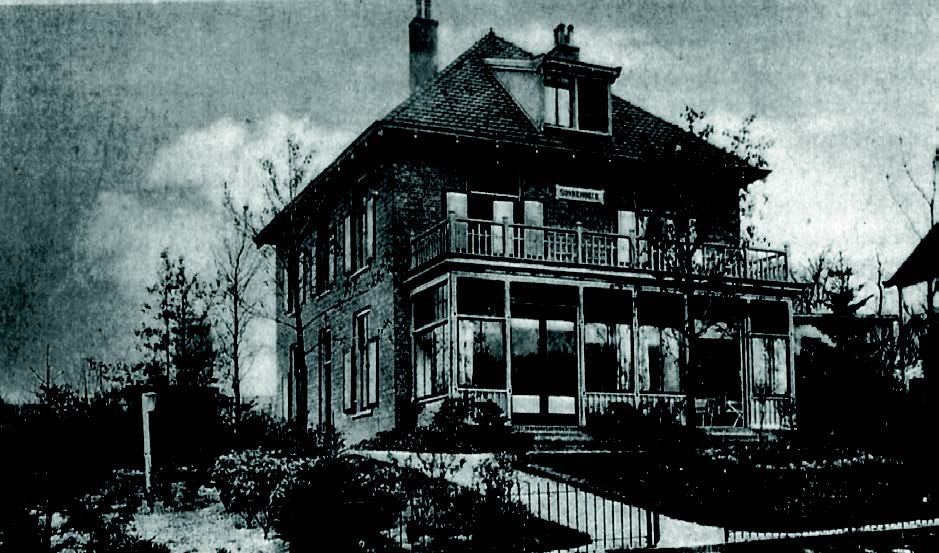
Jonkheer Nedermeijer van Rosenthalweg (Grindweg) nr. 25.
rain barrel, so that ended well … Or did it? The barrel contained our water supply. When the fighting died down, Nel and Miep decided to get some water from the Zweiersdal brook. It was almost evening when they went out with two buckets, both with a white tea towel around their heads for recognition in the dark.
They came back safely, with water! Food was also a problem, but not the most important one. That was the noise! It was so deafening that I often thought: ‘If they’d only stop shooting for just five minutes, then they can continue again for as long as they want’.”
HUNS
“The continuous shelling did put a neighbouring house on fire, after which the group was forced to take refuge elsewhere: Hogerheide 9. The cellar there appeared to be full of hiding Oosterbekers. We didn’t dare go back and so we just sat down in the empty living room, with our hands in front of our faces for protection. That night I experienced what ‘fear of death’ really is. When it got light, Nel went to check on Adriaan’s and Bets’s house.
It did not burn down, probably because of the soaking wet chestnut tree next to it. And so we went back to the small cellar again.” “During one of the final days we suddenly heard music outside. When I also heard an English voice, I concluded that the fight was over and that the Tommies had won.
But later the shooting ‘just’ continued. One night the bombing was stepped up again and stopped abruptly.
The Germans arrived the next morning. They banged their rifles on the door and shouted for us to come out.
Especially our four Jewish aunts must have thought that this was the end. They Germans commanded us to leave to the east. And so a moment later our ragged group walked down the hill, towards Weverstraat.”
EVACUATION
“I don’t think any of us knew what day it was. I now know that it was Tuesday 26 September. Nine days had passed since that sunny ‘liberation day’. We walked through destroyed streets. The road was littered with junk, a tank, containers and parachutes. We heard birdsong again. We tried to go back to our house, but at Emmastraat we were stopped by German soldiers.
Eventually we moved into an abandoned house, Mo-lenweg 12, a saddlery / leather shop.”
Oosterbeek was evacuated, or better: declared Sper-rgebiet. “How we left and why we had to leave the vil-lage, I simply do not know. There was a rumour that the village would be bombed at two in the afternoon, and that we would have to evacuate before that time.
Via busy Utrechtseweg, Noorderweg and Parallelweg we went along the railway tracks towards Wolfheze. Things went terribly wrong in the chaos. I noticed that three of our four Jewish aunts were no longer walking behind us. A little further Uncle Adriaan and aunt Bets were able to catch a ride on a horse and carriage and also disappeared from our sight. With this Robbie, Hanneke, Nel, Miep, Jet and To-bias left the battlefield, leaving Oosterbeek for good. – Robert Gunter (edited by: Alexander Heusschen) – photos: Robert Gunter
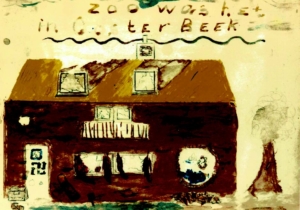
Postscript After some wanderings they ended up on a farm at De Glind, where they were liberated. Clara, Dinie and Net-tie survived the war at a safe address in Apeldoorn. They were liberated by Canadian troops around April 18, 1945. Robbie and his family returned home in June. For Christmas all children from Oosterbeek received presents from England: Robbie got a box with brushes and paint.
The imaginary house he painted with these things was given the title ‘Zoo was het in Oosterbeek’ [Oosterbeek as it was]. Robert Gunter nowadays lives in Roosendaal, province of Noord-Brabant.
HISTORICAL PERSPECTIVE
DEATH ON DREIJENSEWEG
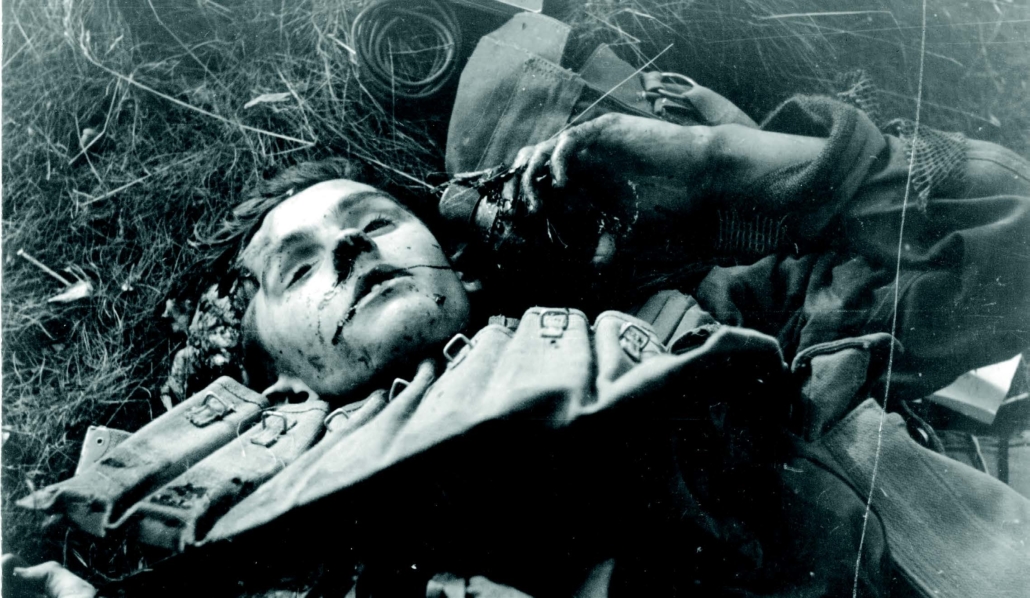
(Bron: Bundesarchiv, Bild 101II-M2KBK-771-36 HQ / fotograaf: PK-Kriegsberichter Höppner).
This photo is the most shocking image I know of the Battle of Arnhem. In addition to the horrific details, this is also due to the absent look in the eyes: this is what death looks like. It is also one of the lesser-known photographs of the battle; apart from a few exceptions, it has not been published or otherwise shown. The German Bundesarchiv is the owner of it and is not the only one from the series of PK-Kriegsberichter Höppner on their website “for legal or other reasons”. Possibly this reluctance stems from piety with the victim’s family or to protect young generations from shocking images. War is indeed terrible in its horror and arbitrari-ness. But if we want to read and learn about this war, then this kind of image is part of it.
The photo of the dead para with a grenade in his left hand was taken on September 20, 1944 near the Dreijenseweg in Oosterbeek. The day before saw heavy fighting along that road in the attempts of the 4th Parachute Brigade to conquer the higher ground of Lichtenbeek and thus gain a better position on the western access roads to Arnhem. The attempts failed miserably, with great losses for the British, and on the 20th the road was firmly in the hands of the Germans.
The grenade the dead para holds in his hand is a Gammon bomb (Image 2), a weapon that was particularly popular with Air-borne units for close combat against armoured vehicles. The grenade was hand thrown and detonated on impact. The ignit-er was armed by the thrower by pulling a ribbon attached to the pin. The ribbon was protected by a screw cap that had to be removed before throwing.
In the photo of the para, the screw head is still on the grenade. The inventor of the ‘bomb’ was Lieu-tenant Bob Gammon, one of the first officers of the 1st Battalion The Parachute Regiment. Gammon was wounded during the invasion of Sicily and, due to damage to his hearing, was to his dismay rejected for further service with the Parachute Regiment and was therefore not present in Arnhem.
FLAKPANZERS
The photo of the victim comes from one of the two films that Höppner made on and near the Drei-jenseweg. The two photos directly in front, imag-es 34 and 35 of the roll, are well known and show two passing ‘Möbelwagen’ (Flakpanzers) from the 9th Waffen-SS division (image 3). These photo-graphs of the battle are of great historical value be-cause they form visual proof of the type of material against which the Airbornes had to take up. Perhaps one of these Flakpanzers was the target of the de-picted fallen Airborne, the day before. The location of the photos of the Flakpanzers is approximately halfway between the Dreijenseweg, between Ooster-beek-Hoog station and the Amsterdamseweg.
In John O’Reilly’s book on the 156th Battalion, ‘From Delhi to Arnhem’, the following passage ap-pears about the fighting on the Dreijenseweg (p. 166): “Turning to the soldier on his right, Waddy told him to toss a grenade at the flak gun. As the man prepared to throw a grenade, a bullet smacked into his fore-head, killing him instantly. ” What if…?
SKIRMISH
The source of this story is John Waddy himself. He was company commander in the 156th Battalion during the battle and was wounded in the attempts to conquer the Dreijenseweg. In Ministory 105 from 2010 he describes the incident: “Then suddenly I saw the cannon, at the end of the road. It was a dou-ble-barreled 20mm Flak cannon on a semi-track vehi-cle. Because it was on my advance route, I decided to go forward and try to put the piece out of combat in collaboration with a few of my soldiers. We marched through the bushes, until we approached the cannon at fifteen meters. The Germans screamed at each oth-er and I could hear the empty grenade shells rattling on the floor of the half tracked vehicle. It was at that very moment that the soldier on my right got a bullet in his forehead. I saw that there was a German sniper in the tree above the cannon. I only had my Colt .45 gun with me and fired five shots at him and at that moment he or another German shot me in the ab-domen.” During a battlefield tour in Oosterbeek in 2012 I was given the opportunity to show the photo to John Waddy himself. He remembered the incident, but he could neither confirm nor deny that the photo was part of it. He did say that he found his backpack in the same place after the war. The location of this Waddy skirmish is precisely known: it is where the forest path from the former water tower, now a burial monument of mission house Vrijland, comes from the forest plot east of the Johannahoeve and ends perpen-dicular to the Dreijenseweg (see: O’Reilly, p. 160).
This water tower was more or less the basis from which the 156th Battalion carried out its various at-tacks on this road that morning. The location where the path ends at the Dreijenseweg, is about the same place where the photos of the Flakpanzers were made by Höppner the next day. If we assume that the photo of the fallen Brit was also taken in the surroundings, we can assume it is the soldier that got shot as de-scribed by Waddy. With that it is also likely that he belonged to the 156th Battalion and we can try to give the unfortunate Brit a name.
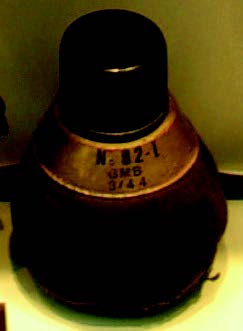
Pic 2: een Gammon bomb.
CASUALTY DETAILS
The best available source for the location of field graves is the Roll of Honour compiled by Jan Hey.
We have to look a little further than just the date of death, known to us to be September 19. Unfortunate-ly, these data are often not or not correctly registered in the official source data. The unit can also give a clue, the battle at this exact location was mainly con-ducted by 4th and 5th Platoon of A Company (3rd
Platoon was still on the Ginkelse Heide) and Waddy’s B Company of the 156th Battalion. In addition to a number of victims on the 19th with a ‘No Known Grave’, there are a few candidates whose field grave was in the vicinity of this place. The closest thing comes to the description of Private Layton, whose field grave was “in a wood west of Dreijenseweg”. He belonged to the 5th Platoon of A Company, the pla-toon of Lieutenant Delacour who himself fell a little 100 meters further west along the path in the forest. It is also described that elements of A Company merged with Waddy’s B Company when it attacked. A Com-pany’s commander, Major Pott, had managed to cross the Dreijenseweg and reach Lichtenbeek with the remainder of his 4th Platoon. That Waddy, together with Layton, attacked the German armoured vehicle on the western side of the Dreijenseweg is therefore highly likely. A photo of Layton appears to have been published in a local British Roll of Honour just af-ter the war (Figure 5). There are a number of details that are very similar to the fallen Brit in the Höppner photo: the haircut and the hairline, the left slightly protruding ear, the chin and jawline and the crooked front tooth. Enough clues to make an attempt to ob-tain a positive identification through possibly living family members, if these can be found. In addition to the horrific image, the photo hopefully also offers comfort; at least this soldier did not suffer. Moreover, the photo also shows his courage: it takes a lot to at-tack an enemy armoured vehicle a few meters away with nothing else but a hand grenade.
From his casualty details we know that this is George William Layton, 25 years of age in Sep-tember 1944, hus-band of Marjorie Mary Layton from Balsall Heath, Bir-mingham. There are several genea-logical internet sites nowadays, and es-pecially British data are easily accessible. Through the site ‘Find my past’ I got the following information: George was born in Jul-Aug-Sept 1919 in Auckland, Durham. Striking is the mentioned “Mother’s maid-en name”, which is given as Layton. You would expect that as his father’s name. Marjorie was born in Jan-Feb-Mar 1925 in Uppingham, Rutlandshire.
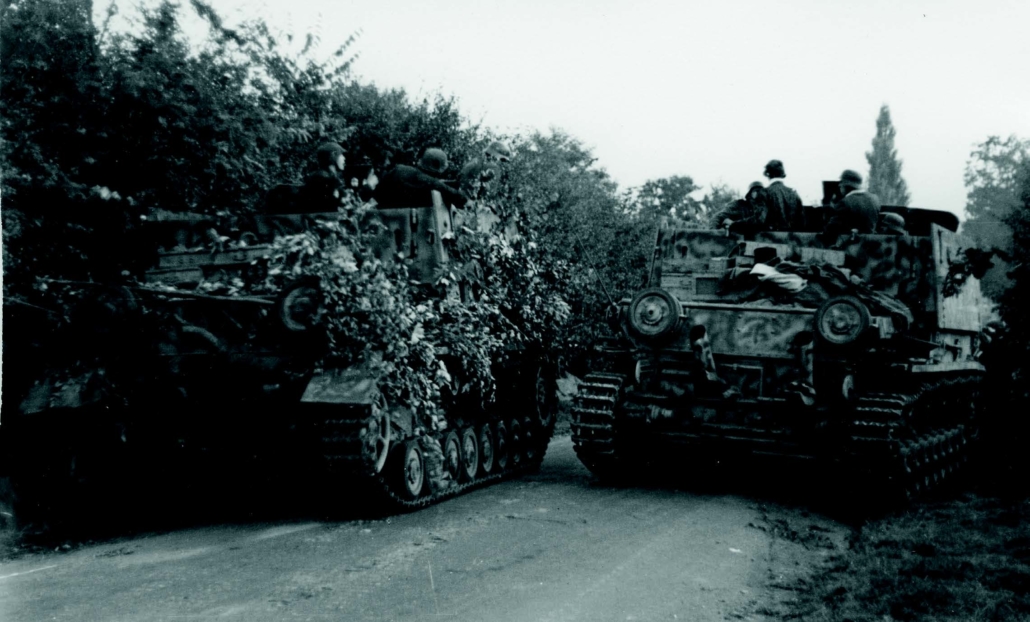
Image 3: Two Flakpanzers on the Dreijensweweg, the day after the para got killed (source: Bundesarchiv, Bild 101II-M2KBK-771-34 HQ / photographer: PK-Kriegsberichter Höppner / image 34. Image 35 was not available through the Bundesarchiv at the time of publication of this article).
MEANING
The next step is trying to find a wedding date to make it easier to search for any children. The marriage cer-tificate specifies the date as 19 February 1944. George would have been 24 then and Marjorie 18. Witnesses were Albert Edward Corrall, the father of the bride, and from the side of the groom R.G. Coates and J.
Coates. His father is mentioned with a striking double
surname: Percy Coates Layton. The birth certificate of George Layton, which I also requested, gives a defi-nite answer: under his mother’s name it says ‘Eliza-beth Ann Layton’. Under his father’s just “-”. George’s father was no longer there when he was born, and his mother apparently did not want to have his name mentioned. Hence his last name is his mother’s name.
Further research yields that his mother Elisabeth was born in Oct-Nov-Dec 1901, so she was only 17 when she became pregnant with George. Another suspicion is also confirmed: in 1922 Elisabeth Ann Layton mar-ried Percy Coates, George is then two years old. Here too we can only guess at the true story, but it seems noble that Percy Coates took care of an unmarried mother and her child at that time. The couple had two sons, half-brothers of George and both born in Auckland, Durham: John Coates in 1923 and Regi-nald G. Coates in 1925. That completes the circle, because these are the two witnesses mentioned at George and Marjorie’s wedding. Based on this infor-mation, a thorough search was made for contact de-tails of any family members still alive. Unfortunately, this search has not produced any results. His wife is probably no longer alive, no address can be found for his half-brothers; the name Coates is common. A contact note left on Layton’s grave at the Airborne Cemetery around the time of the 70th commemora-tion availed to nothing.
Unfortunately, we cannot identify the fallen soldier with certainty. But if we assume that the brave man in the photo is Layton, then there is now more meaning behind Grave 32.B.6. at the cemetery in Oosterbeek then just the text “Thank you God, for the memory of a man so very fine. Life is Eternal, he has not died.”
– Paul Meiboom – Comments: pemeiboom@gmail.com
CASUALTY DETAILS
De best beschikbare bron voor de locatie van veldgraven is de door Jan Hey samengestelde Roll of Honour.
Hierbij moeten we wat ruimer zoeken dan alleen op de bij ons bekende overlijdensdatum van 19 september; helaas zijn deze data vaak niet of niet correct geregistreerd in de officiële brongegevens. Ook de eenheid
kan een aanwijzing geven, de strijd op deze exacte plek werd vooral gevoerd door 4th en 5th Platoon van A Company (3rd Platoon was nog op de Ginkelse Heide) en Waddy’s B Company van het 156st Battalion.
Naast een aantal slachtoffers op de 19e met een ‘No Known Grave’, zijn er een paar kandidaten waarvan het veldgraf zich bevond in de omgeving van deze plek. Het meest in de buurt komt de beschrijving van Private Layton, wiens veldgraf “in a wood west of Dreijenseweg” lag. Hij behoorde tot het 5th Platoon van A Company, het peloton van Lieutenant Delacour die zelf een kleine 100 meter verder westwaarts langs het bewuste pad in het bos sneuvelde. Er wordt ook beschreven dat elementen van A Company opgeslokt werden door Waddy’s B Company als deze als tweede aanvalt. A Company’s commandant, Major Pott, was met het restant van zijn 4th Platoon erin geslaagd de Dreijenseweg over te steken en Lichtenbeek te bereiken. Dat Waddy samen met Layton het Duitse pantervoertuig aanviel aan de westelijke kant van de Dreijenseweg is dus zeer goed mogelijk.
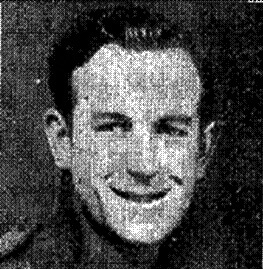
Pte George William Layton.
JUST PUBLISHED 9. SS-PANZER-DIVISION HOHENSTAUFEN 1943-1944
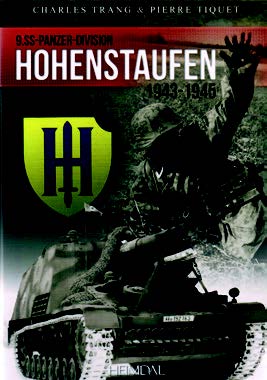 In 1984 a book about the history of the 9. SS-Pan-zer-Division Hohenstaufen in 1944 was published by the French publisher Heimdal. It was written by Her-bert Furbringer, a veteran of the 9th.
In 1984 a book about the history of the 9. SS-Pan-zer-Division Hohenstaufen in 1944 was published by the French publisher Heimdal. It was written by Her-bert Furbringer, a veteran of the 9th.
Heimdal recently published a new book about the Hohenstaufen, using Furbringer’s sources. It describes the entire period of existence of the division from December 31, 1942 to May 8, 1945. The 28 pages devoted to ‘The return to the Netherlands and the battle of Arnhem’ are really worth reading. Take, for example, the handy list of locations where the division units were stationed around Arnhem from the 6th of September onward, and which units remained behind at the Belgian-Dutch border or were transferred to the 10. SS-Panzer-Grenadier-Division ‘Frundsberg’.
This is followed by a day-to-day summary of the Ger-man countermeasures and the course of the fighting.
Unfortunately, some errors have crept into the place name. Some photos are less known or new. Also slightly annoying is the fact that the captions are of-
ten incorrect; Ooster-beek and Arnhem are mixed up for example.
A few things could also be said about the source references.
Regardless, the book is highly recommend-ed for those interested in the 9th. It contains no new insights, but the German actions are well put together. The price for all of this is a small loss. – Wybo Boersma Charles Trang & Pierre Tiquet, 9. SS-Panzer-Division Hohenstaufen 1943-1944 (Éditions Heimdal, Bayeux, France), 415 pages in French, illustrated, ISBN 978-2-84048-472-1, € 79
2CM FLAK SLEEVE
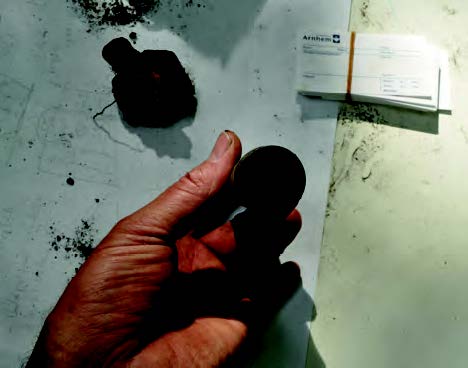 On Wednesday the 25th of September 2019, a Ger-man bunker was excavated in the garden of ‘the monastry’ (Museum Arnhem) on Utrechtseweg. Im-mediately below ground level, archaeologists found an old trench filled with the rubble of the destroyed city. Traces of fighting were found between the bricks, glassware and household effects. Did these come from the fighting on that fatal Tuesday, the 19th of Septem-ber 1944, when the advance of the Staffords ended in the monastry? The archaeologists registered a German 2cm-sleeve of a Flak canon. Could it have been fired by one of the Flak 38s that were deployed along Utrechtseweg on that day?
On Wednesday the 25th of September 2019, a Ger-man bunker was excavated in the garden of ‘the monastry’ (Museum Arnhem) on Utrechtseweg. Im-mediately below ground level, archaeologists found an old trench filled with the rubble of the destroyed city. Traces of fighting were found between the bricks, glassware and household effects. Did these come from the fighting on that fatal Tuesday, the 19th of Septem-ber 1944, when the advance of the Staffords ended in the monastry? The archaeologists registered a German 2cm-sleeve of a Flak canon. Could it have been fired by one of the Flak 38s that were deployed along Utrechtseweg on that day?
Map and GPS-coördinaten ‘Set in Stone’
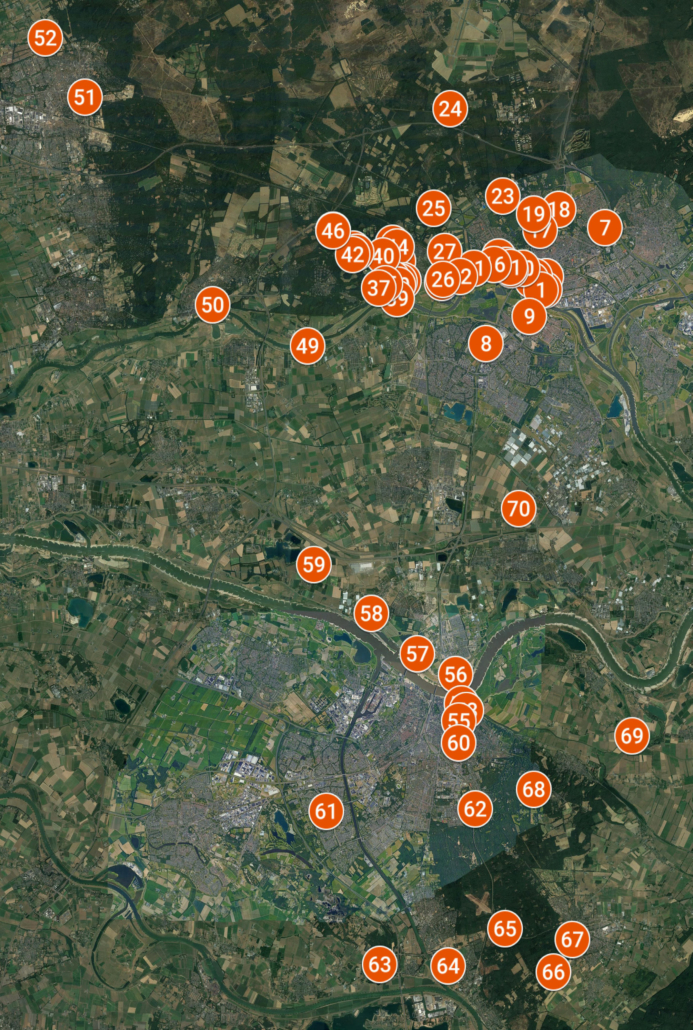
1 51.976773, 5.912996
2 51.976859, 5.915077
3 51.980893, 5.915831
4 51.979072, 5.913669
5 51.980946, 5.909962
6 51.979917, 5.908068
7 51.996118, 5.947019
8 51.960141, 5.883701
9 51.968598, 5.906762
10 51.983579, 5.903326
11 51.98382, 5.89671
12 51.98317, 5.89716
13 51.98445, 5.89455
14 51.98520, 5.89300
15 51.98542, 5.89245
16 51.98476, 5.88810
17 51.995400, 5.912636
18 52.00199, 5.92438
19 52.00146, 5.90786
20 51.987080, 5.890621
21 51.983606, 5.877466
22 51.981058, 5.870214
23 52.00603, 5.89286
24 52.033252, 5.865027
25 52.002272, 5.856160
26 51.98016, 5.86101
27 51.988827, 5.861942
28 51.979199, 5.860346
29 51.979725, 5.840265
30 51.978370, 5.837341
31 51.979470, 5.838190
32 51.979198, 5.838160
33 51.980339, 5.834410
34 51.980321, 5.833101
35 51.978790, 5.830450
36 51.977481, 5.829617
37 51.977478, 5.826933
38 51.977643, 5.834590
39 51.97420, 5.83667
40 51.981918, 5.823608
41 51.987719, 5.832690
42 51.98746, 5.82918
43 51.988621, 5.815256
44 51.987922, 5.813114
45 51.985804, 5.837386
46 51.990264, 5.836667
47 51.991390, 5.834304
48 51.995316, 5.802741
49 51.989612, 5.813446
50 51.995513, 5.802705
51 51.95948, 5.78919
52 51.97229,5.73880
53 52.036910, 5.670948
54 52.055367, 5.649778
55 51.846011, 5.873032
56 51.848073, 5.870433
57 51.842738, 5.869012
58 51.85722, 5.86740
59 51.86368, 5.84714
60 51.876264, 5.822857
61 51.891476, 5.792436
62 51.835950, 5.868930
63 51.814719, 5.798897
64 51.815374, 5.877598
65 51.767026, 5.827104
66 51.766521, 5.863183
67 51.778077, 5.893265
68 51.764555, 5.918816
69 51.774655, 5.928863
70 51.821436, 5.908623
71 51.837989, 5.960686
72 51.90878, 5.90095
73 51.936806, 5.581643
74 51.884919, 5.438232
75 51.944930, 4.861197
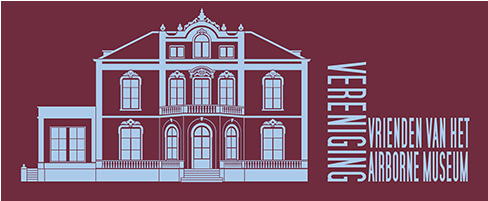
Plaats een Reactie
Vraag of reactie?Laat hier uw reactie achter.